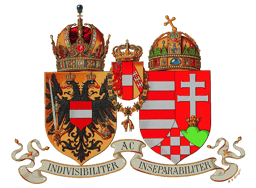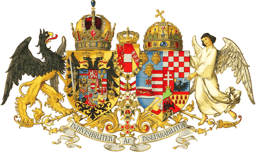Austria-Hungary
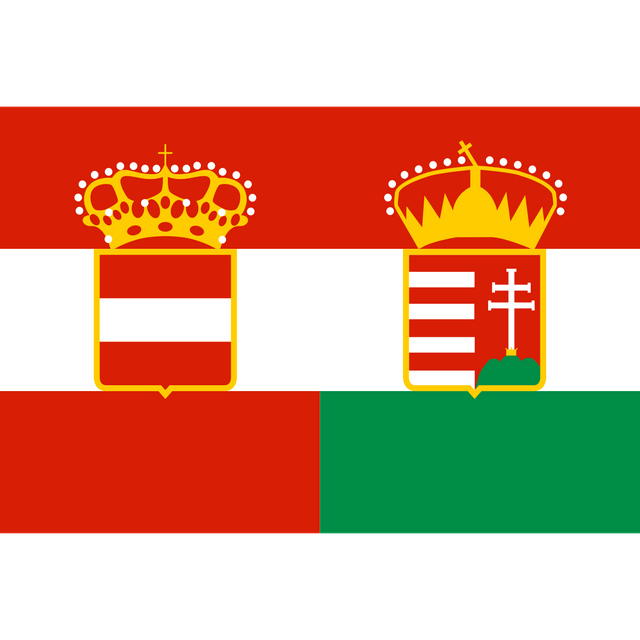
Austria-Hungary

Austro-Hungarian Empire↓ | |||||||||||||||||||||||
|---|---|---|---|---|---|---|---|---|---|---|---|---|---|---|---|---|---|---|---|---|---|---|---|
| 1867–1918 | |||||||||||||||||||||||
Civil ensign[1] | |||||||||||||||||||||||
**Motto:**Indivisibiliter ac inseparabiliter ‘Indivisibly and inseparably’ | |||||||||||||||||||||||
**Anthem:**Gott erhalte, Gott beschütze ’God shall save, God shall protect‘ | |||||||||||||||||||||||
 Austria-Hungary on the eve of World War I | |||||||||||||||||||||||
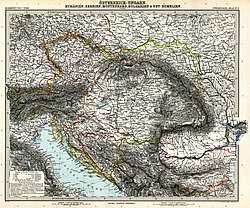 Austria-Hungary between 1878 and 1914 at its greatest exent (Stielers Handatlas) | |||||||||||||||||||||||
| Capital | Vienna[3] (Cisleithania) Budapest (Transleithania) | ||||||||||||||||||||||
| Official languages | Other spoken languages: Czech, Slovak, Yiddish, Slovene, Serbian, Bosnian, Polish, Romanian, Rusyn, Ukrainian, Carpathian Romani[5] | ||||||||||||||||||||||
| Religion | 76.6% Catholic (incl. 64–66% Latin & 10–12% Eastern) 8.9% Protestant (Lutheran, Reformed, Unitarian) 8.7% Orthodox 4.4% Jewish 1.3% Muslim (1910 census[6]) | ||||||||||||||||||||||
| Demonym(s) | Austro-Hungarian | ||||||||||||||||||||||
| Government | Constitutional dual monarchy | ||||||||||||||||||||||
| Emperor-King | |||||||||||||||||||||||
• 1867–1916 | Franz Joseph I | ||||||||||||||||||||||
• 1916–1918 | Charles I & IV | ||||||||||||||||||||||
| Minister-President of Austria | |||||||||||||||||||||||
• 1867 (first) | Friedrich Ferdinand von Beust | ||||||||||||||||||||||
• 1918 (last) | Heinrich Lammasch | ||||||||||||||||||||||
| Prime Minister of Hungary | |||||||||||||||||||||||
• 1867–1871 (first) | Gyula Andrássy | ||||||||||||||||||||||
• 1918 (last) | János Hadik | ||||||||||||||||||||||
| Legislature | 2 national legislatures | ||||||||||||||||||||||
• Imperial Council | Herrenhaus Abgeordnetenhaus | ||||||||||||||||||||||
• Diet of Hungary | House of Magnates House of Representatives | ||||||||||||||||||||||
| Historical era | New Imperialism • World War I | ||||||||||||||||||||||
• 1867 Compromise | 30 March 1867 | ||||||||||||||||||||||
• Dual Alliance | 7 October 1879 | ||||||||||||||||||||||
• Bosnian Crisis | 6 October 1908 | ||||||||||||||||||||||
• July Crisis | 28 June 1914 | ||||||||||||||||||||||
• Invasion of Serbia | 28 July 1914 | ||||||||||||||||||||||
• Empire dissolved | 31 October 1918 | ||||||||||||||||||||||
• Austrian Republic | 12 November 1918 | ||||||||||||||||||||||
• Hungarian Republic | 16 November 1918 | ||||||||||||||||||||||
• Treaty of Saint-Germain | 10 September 1919 | ||||||||||||||||||||||
• Treaty of Trianon | 4 June 1920 | ||||||||||||||||||||||
| Area | |||||||||||||||||||||||
| 1905[7] | 621,537.58 km2(239,977.00 sq mi) | ||||||||||||||||||||||
| Population | |||||||||||||||||||||||
• 1914 | 52,800,000 | ||||||||||||||||||||||
| Currency |
| ||||||||||||||||||||||
| |||||||||||||||||||||||
| Linguistic distribution of Austria-Hungary as a whole | |||||||||||||||||||||||
| German | 24% | ||||||||||||||||||||||
| Hungarian | 20% | ||||||||||||||||||||||
| Czech | 13% | ||||||||||||||||||||||
| Polish | 10% | ||||||||||||||||||||||
| Ruthenian | 8% | ||||||||||||||||||||||
| Romanian | 6% | ||||||||||||||||||||||
| Croat | 5% | ||||||||||||||||||||||
| Slovak | 4% | ||||||||||||||||||||||
| Serbian | 4% | ||||||||||||||||||||||
| Slovene | 3% | ||||||||||||||||||||||
| Italian | 3% | ||||||||||||||||||||||
Austria-Hungary, often referred to as the Austro-Hungarian Empire or the Dual Monarchy, was a constitutional monarchy in Central and Eastern Europe between 1867 and 1918. It was formed when the Austrian Empire adopted a new constitution; as a result Austria (Cisleithania) and Hungary (Transleithania) were placed on equal footing. It dissolved into several new states at the end of the First World War.
The union was established by the Austro-Hungarian Compromise of 1867 on 30 March 1867 in the aftermath of the Austro-Prussian War. It consisted of two monarchies (Austria and Hungary), and one autonomous region: the Kingdom of Croatia-Slavonia under the Hungarian crown, which negotiated the Croatian–Hungarian Settlement in 1868. It was ruled by the House of Habsburg, and constituted the last phase in the constitutional evolution of the Habsburg Monarchy. Following the 1867 reforms, the Austrian and Hungarian states were co-equal in power. Foreign and military affairs came under joint oversight, but all other governmental faculties were divided between respective states.
Austria-Hungary was a multinational state and one of Europe's major powers at the time. Austria-Hungary was geographically the second-largest country in Europe after the Russian Empire, at 621,538 km2 (239,977 sq mi),[8] and the third-most populous (after Russia and the German Empire). The Empire built up the fourth-largest machine building industry of the world, after the United States, Germany, and the United Kingdom.[9] Austria-Hungary also became the world's third largest manufacturer and exporter of electric home appliances, electric industrial appliances and power generation apparatus for power plants, after the United States and the German Empire.[10][11]
After 1878, Bosnia and Herzegovina came under Austro-Hungarian military and civilian rule[12] until it was fully annexed in 1908, provoking the Bosnian crisis among the other powers.[13] The northern part of the Ottoman Sanjak of Novi Pazar was also under de facto joint occupation during that period but the Austro-Hungarian army withdrew as part of their annexation of Bosnia.[14] The annexation of Bosnia also led to Islam being recognized as an official state religion due to Bosnia's Muslim population.[15]
Austria-Hungary was one of the Central Powers in World War I, which began with an Austro-Hungarian war declaration on the Kingdom of Serbia on 28 July 1914. It was already effectively dissolved by the time the military authorities signed the armistice of Villa Giusti on 3 November 1918. The Kingdom of Hungary and the First Austrian Republic were treated as its successors de jure, whereas the independence of the West Slavs and South Slavs of the Empire as the First Czechoslovak Republic, the Second Polish Republic and the Kingdom of Yugoslavia, respectively, and most of the territorial demands of the Kingdom of Romania were also recognized by the victorious powers in 1920.
Austro-Hungarian Empire↓ | |||||||||||||||||||||||
|---|---|---|---|---|---|---|---|---|---|---|---|---|---|---|---|---|---|---|---|---|---|---|---|
| 1867–1918 | |||||||||||||||||||||||
Civil ensign[1] | |||||||||||||||||||||||
**Motto:**Indivisibiliter ac inseparabiliter ‘Indivisibly and inseparably’ | |||||||||||||||||||||||
**Anthem:**Gott erhalte, Gott beschütze ’God shall save, God shall protect‘ | |||||||||||||||||||||||
 Austria-Hungary on the eve of World War I | |||||||||||||||||||||||
 Austria-Hungary between 1878 and 1914 at its greatest exent (Stielers Handatlas) | |||||||||||||||||||||||
| Capital | Vienna[3] (Cisleithania) Budapest (Transleithania) | ||||||||||||||||||||||
| Official languages | Other spoken languages: Czech, Slovak, Yiddish, Slovene, Serbian, Bosnian, Polish, Romanian, Rusyn, Ukrainian, Carpathian Romani[5] | ||||||||||||||||||||||
| Religion | 76.6% Catholic (incl. 64–66% Latin & 10–12% Eastern) 8.9% Protestant (Lutheran, Reformed, Unitarian) 8.7% Orthodox 4.4% Jewish 1.3% Muslim (1910 census[6]) | ||||||||||||||||||||||
| Demonym(s) | Austro-Hungarian | ||||||||||||||||||||||
| Government | Constitutional dual monarchy | ||||||||||||||||||||||
| Emperor-King | |||||||||||||||||||||||
• 1867–1916 | Franz Joseph I | ||||||||||||||||||||||
• 1916–1918 | Charles I & IV | ||||||||||||||||||||||
| Minister-President of Austria | |||||||||||||||||||||||
• 1867 (first) | Friedrich Ferdinand von Beust | ||||||||||||||||||||||
• 1918 (last) | Heinrich Lammasch | ||||||||||||||||||||||
| Prime Minister of Hungary | |||||||||||||||||||||||
• 1867–1871 (first) | Gyula Andrássy | ||||||||||||||||||||||
• 1918 (last) | János Hadik | ||||||||||||||||||||||
| Legislature | 2 national legislatures | ||||||||||||||||||||||
• Imperial Council | Herrenhaus Abgeordnetenhaus | ||||||||||||||||||||||
• Diet of Hungary | House of Magnates House of Representatives | ||||||||||||||||||||||
| Historical era | New Imperialism • World War I | ||||||||||||||||||||||
• 1867 Compromise | 30 March 1867 | ||||||||||||||||||||||
• Dual Alliance | 7 October 1879 | ||||||||||||||||||||||
• Bosnian Crisis | 6 October 1908 | ||||||||||||||||||||||
• July Crisis | 28 June 1914 | ||||||||||||||||||||||
• Invasion of Serbia | 28 July 1914 | ||||||||||||||||||||||
• Empire dissolved | 31 October 1918 | ||||||||||||||||||||||
• Austrian Republic | 12 November 1918 | ||||||||||||||||||||||
• Hungarian Republic | 16 November 1918 | ||||||||||||||||||||||
• Treaty of Saint-Germain | 10 September 1919 | ||||||||||||||||||||||
• Treaty of Trianon | 4 June 1920 | ||||||||||||||||||||||
| Area | |||||||||||||||||||||||
| 1905[7] | 621,537.58 km2(239,977.00 sq mi) | ||||||||||||||||||||||
| Population | |||||||||||||||||||||||
• 1914 | 52,800,000 | ||||||||||||||||||||||
| Currency |
| ||||||||||||||||||||||
| |||||||||||||||||||||||
| Linguistic distribution of Austria-Hungary as a whole | |||||||||||||||||||||||
| German | 24% | ||||||||||||||||||||||
| Hungarian | 20% | ||||||||||||||||||||||
| Czech | 13% | ||||||||||||||||||||||
| Polish | 10% | ||||||||||||||||||||||
| Ruthenian | 8% | ||||||||||||||||||||||
| Romanian | 6% | ||||||||||||||||||||||
| Croat | 5% | ||||||||||||||||||||||
| Slovak | 4% | ||||||||||||||||||||||
| Serbian | 4% | ||||||||||||||||||||||
| Slovene | 3% | ||||||||||||||||||||||
| Italian | 3% | ||||||||||||||||||||||
Structure and name
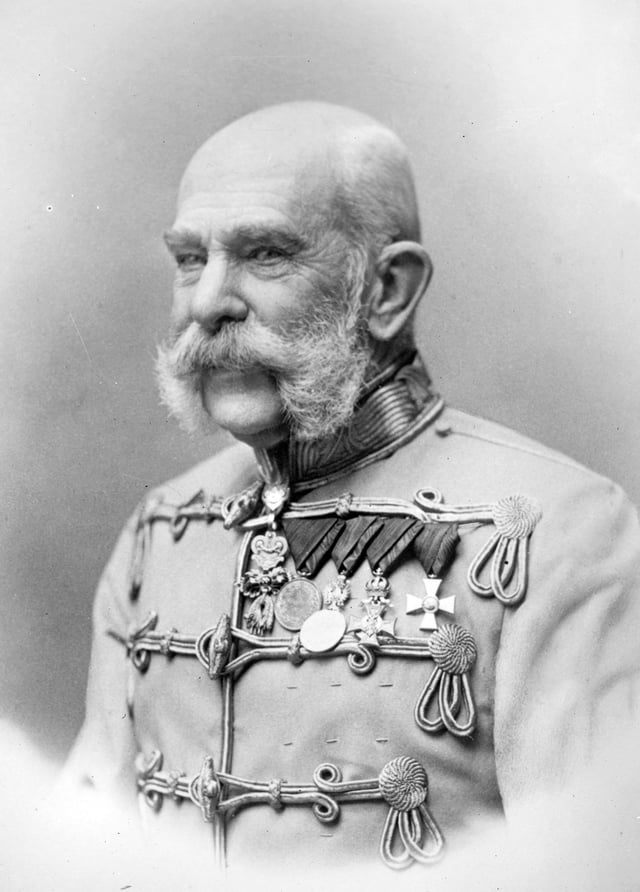
Emperor Franz Joseph I in 1905
The realm's official name was in Österreichisch-Ungarische Monarchie and in Osztrák–Magyar Monarchia (English: Austro-Hungarian Monarchy),[16] though in international relations Austria-Hungary was used (German: Österreich-Ungarn, Hungarian: Ausztria-Magyarország). The Austrians also used the names k. u. k. Monarchie (English: "k. u. k. monarchy)[17] (in detail German: Kaiserliche und königliche Monarchie Österreich-Ungarn, Hungarian: Császári és Királyi Osztrák–Magyar Monarchia)[18] and Danubian Monarchy (German: Donaumonarchie, Hungarian: Dunai Monarchia) or Dual Monarchy (German: Doppel-Monarchie, Hungarian: Dual-Monarchia) and The Double Eagle (German: Der Doppel-Adler, Hungarian: Kétsas), but none of these became widespread either in Hungary, or elsewhere.
The realm's full name used in the internal administration was The Kingdoms and Lands Represented in the Imperial Council and the Lands of the Holy Hungarian Crown of St. Stephen.
German: Die im Reichsrat vertretenen Königreiche und Länder und die Länder der Heiligen Ungarischen Stephanskrone
Hungarian: A Birodalmi Tanácsban képviselt királyságok és országok és a Magyar Szent Korona országai
The Habsburg monarch ruled as Emperor of Austria[19] over the western and northern half of the country that was the Austrian Empire ("Lands Represented in the Imperial Council", or Cisleithania)[8] and as King of Hungary[19] over the Kingdom of Hungary ("Lands of the Crown of Saint Stephen", or Transleithania).[8] Each enjoyed considerable sovereignty with only a few joint affairs (principally foreign relations and defence).[20]
Certain regions, such as Polish Galicia within Cisleithania and Croatia within Transleithania, enjoyed autonomous status, each with its own unique governmental structures (see: Polish Autonomy in Galicia and Croatian–Hungarian Settlement).
The division between Austria and Hungary was so marked that there was no common citizenship: one was either an Austrian citizen or a Hungarian citizen, never both.[21][22] This also meant that there were always separate Austrian and Hungarian passports, never a common one.[23][24] However, neither Austrian nor Hungarian passports were used in the Kingdom of Croatia-Slavonia. Instead, the Kingdom issued its own passports which were written in Croatian and French and displayed the coat of arms of the Kingdom of Croatia-Slavonia-Dalmatia on them.[25] It is not known what kind of passports were used in Bosnia-Herzegovina, which was under the control of both Austria and Hungary.
The Kingdom of Hungary had always maintained a separate parliament, the Diet of Hungary, even after the Austrian Empire was created in 1804.[26] The administration and government of the Kingdom of Hungary (until 1848–49 Hungarian revolution) remained largely untouched by the government structure of the overarching Austrian Empire. Hungary's central government structures remained well separated from the Austrian imperial government. The country was governed by the Council of Lieutenancy of Hungary (the Gubernium) – located in Pressburg and later in Pest – and by the Hungarian Royal Court Chancellery in Vienna.[27] The Hungarian government and Hungarian parliament were suspended after the Hungarian revolution of 1848, and were reinstated after the Austro-Hungarian Compromise in 1867.
Despite Austria and Hungary sharing a common currency, they were fiscally sovereign and independent entities.[28] Since the beginnings of the personal union (from 1527), the government of the Kingdom of Hungary could preserve its separate and independent budget. After the revolution of 1848–1849, the Hungarian budget was amalgamated with the Austrian, and it was only after the Compromise of 1867 that Hungary obtained a separate budget.[29] From 1527 (the creation of the monarchic personal union) to 1851, the Kingdom of Hungary maintained its own customs controls, which separated her from the other parts of the Habsburg-ruled territories.[30] After 1867, the Austrian and Hungarian customs union agreement had to be renegotiated and stipulated every ten years. The agreements were renewed and signed by Vienna and Budapest at the end of every decade because both countries hoped to derive mutual economic benefit from the customs union. The Austrian Empire and Kingdom of Hungary contracted their foreign commercial treaties independently of each other.[8]
Austria-Hungary was a great power but it contained a large number of ethnic groups that sought their own nation. The Dual Monarchy was effectively ruled by a coalition of the two most powerful and numerous ethnic groups, the Germans and the Hungarians. Stresses regarding nationalism were building up, and the severe shock of a poorly handled war caused the system to collapse.[31][32]
Vienna served as the Monarchy's primary capital. The Cisleithanian (Austrian) part contained about 57 percent of the total population and the larger share of its economic resources, compared to the Hungarian part.
Following a decision of Franz Joseph I in 1868, the realm bore the official name Austro-Hungarian Monarchy/Realm (German: Österreichisch-Ungarische Monarchie/Reich; Hungarian: Osztrák–Magyar Monarchia/Birodalom) in its international relations. It was often contracted to the Dual Monarchy in English, or simply referred to as Austria.[33]
Creation
The Austro-Hungarian Compromise of 1867 (called the Ausgleich in German and the Kiegyezés in Hungarian), which inaugurated the empire's dual structure in place of the former Austrian Empire (1804–1867), originated at a time when Austria had declined in strength and in power—both in the Italian Peninsula (as a result of the Second Italian War of Independence of 1859) and among the states of the German Confederation (it had been surpassed by Prussia as the dominant German-speaking power following the Austro-Prussian War of 1866).[34] The Compromise re-established[35] the full sovereignty of the Kingdom of Hungary, which was lost after the Hungarian Revolution of 1848.
Other factors in the constitutional changes were continued Hungarian dissatisfaction with rule from Vienna and increasing national consciousness on the part of other nationalities (or ethnicities) of the Austrian Empire. Hungarian dissatisfaction arose partly from Austria's suppression with Russian support of the Hungarian liberal revolution of 1848–49. However, dissatisfaction with Austrian rule had grown for many years within Hungary and had many other causes.
By the late 1850s, a large number of Hungarians who had supported the 1848–49 revolution were willing to accept the Habsburg monarchy. They argued that while Hungary had the right to full internal independence, under the Pragmatic Sanction of 1713, foreign affairs and defense were "common" to both Austria and Hungary.[36]
After the Austrian defeat at Königgrätz, the government realized it needed to reconcile with Hungary to regain the status of a great power. The new foreign minister, Count Friedrich Ferdinand von Beust, wanted to conclude the stalemated negotiations with the Hungarians. To secure the monarchy, Emperor Franz Joseph began negotiations for a compromise with the Hungarian nobility, led by Ferenc Deák, to ensure their support. In particular, Hungarian leaders demanded and received the Emperor's coronation as King of Hungary and the re-establishment of a separate parliament at Pest with powers to enact laws for the lands of the Holy Crown of Hungary.[36]
From 1867 onwards, the abbreviations heading the names of official institutions in Austria-Hungary reflected their responsibility: k. u. k. (kaiserlich und königlich or Imperial and Royal) was the label for institutions common to both parts of the Monarchy, e.g. the k.u.k. Kriegsmarine (War Fleet) and, during the war, the k.u.k. Armee (Army). There were three k.u.k. or joint ministries:
The Imperial and Royal Ministry of the Exterior and the Imperial House
The Imperial and Royal War Ministry
The Imperial and Royal Ministry of Finance
The last was responsible only for financing the Imperial and Royal household, the diplomatic service, the common army and the common war fleet. All other state functions were to be handled separately by each of the two states.[37]
From 1867 onwards, common expenditures were allocated 70% to Austria and 30% to Hungary. This split had to be negotiated every decade. By 1907, the Hungarian share had risen to 36.4%.[38] The negotiations in 1917 ended with the dissolution of the Dual Monarchy.
The common army changed its label from k.k. to k.u.k. only in 1889 at the request of the Hungarian government.
K. k. (kaiserlich-königlich) or Imperial-Royal was the term for institutions of Cisleithania (Austria); "royal" in this label referred to the Crown of Bohemia.
K. u. (königlich-ungarisch) or M. k. (Magyar királyi) ("Royal Hungarian") referred to Transleithania, the lands of the Hungarian crown. In the Kingdom of Croatia and Slavonia, its autonomous institutions hold k. (kraljevski) ("Royal") as according to the Croatian–Hungarian Settlement the only official language in Croatia and Slavonia was Croatian and those institutions were "only" Croatian.
Government
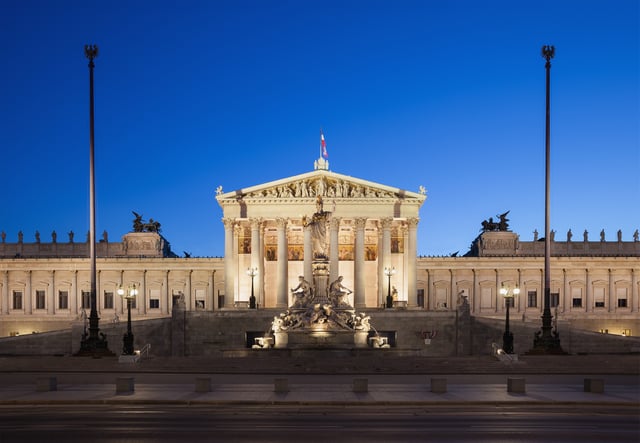
Austrian Parliament building
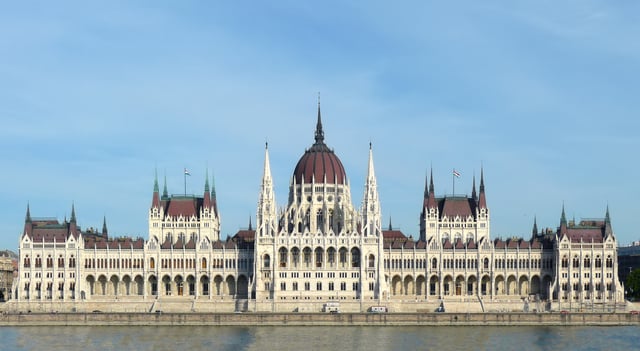
Hungarian Parliament building
There were three parts to the rule of the Austro-Hungarian Empire:[39]
the common foreign, military and a joint financial policy (only for diplomatic, military and naval expenditures) under the monarch
the "Austrian" or Cisleithanian government
the Hungarian government
| ← common emperor-king, common ministries ← entities ← partner states | ||||||||||||||||||||||||||||||||||||||||||||||||||||||||||||||||||||
Hungary and Austria maintained separate parliaments each with its own prime minister. Linking/co-ordinating the two parliaments fell to a government under the monarch. In this sense Austria-Hungary remained under an autocratic government, as the Emperor-King appointed both Austrian and Hungarian Prime ministers along with their respective cabinets. This made both Governments responsible to the Emperor-King, as neither half could have a government with a program contrary to the views of the Monarch. The Emperor-King could appoint non-parliamentary governments, for example, or maintain in power a government which does not have a majority in Parliament to block the formation of another which he does not approve. The Monarch had other prerogatives such as the right of Royal Assent before any kind of Bill would be presented to the National Assembly (the common name for the Hungarian Diet), the right to veto all legislation passed by the National Assembly, and the power to prorogue or dissolve the Assembly and call to new elections (he had the same prerogatives considering the Croatian-Slavonian Diet or Croatian Parliament, the common name for the Croatian-Slavonian Diet). In the Austrian half, however, the Monarchs's power was even greater, as the Emperor had the power to both appoint and dismiss its Prime minister and cabinet members. The monarch's common government, in which its ministers were appointed by the Monarch and responsible to him, had the responsibility for the army, for the navy, for foreign policy, and for the customs union.[36] Due to the lack of common law between Austria and Hungary, to conclude identical texts, each parliament elected 60 of its members to form a delegation that discussed motions of the Imperial and Royal ministries separately and worked towards a compromise.[37]
A common Ministerial Council ruled the common government: it comprised the three ministers for the joint responsibilities (joint finance, military, and foreign policy), the two prime ministers, some Archdukes and the monarch.[40] Two delegations of representatives (60–60 members), one each from the Austrian and Hungarian parliaments, met separately and voted on the expenditures of the Common Ministerial Council giving the two governments influence in the common administration. However, the ministers ultimately answered only to the monarch who had the final decision on matters of foreign and military policy.
Overlapping responsibilities between the joint ministries and the ministries of the two halves caused friction and inefficiencies.[37] The armed forces suffered particularly from overlap. Although the unified government determined the overall military direction, the Austrian and Hungarian governments each remained in charge of recruiting, supplies and training. Each government could have a strong influence over common governmental responsibilities. Each half of the Dual Monarchy proved quite prepared to disrupt common operations to advance its own interests.[40]
Relations during the half-century after 1867 between the two parts of the dual monarchy featured repeated disputes over shared external tariff arrangements and over the financial contribution of each government to the common treasury. Under the terms of the "Austro-Hungarian Compromise of 1867", an agreement renegotiated every ten years, determined these matters. There was political turmoil during the build-up to each renewal of the agreement. The disputes culminated in the early 1900s in a prolonged constitutional crisis. It was triggered by disagreement over which language to use for command in Hungarian army units, and deepened by the advent to power in Budapest in April 1906 of a Hungarian nationalist coalition. Provisional renewals of the common arrangements occurred in October 1907 and in November 1917 on the basis of the status quo.[37]
Judicial system
Empire of Austria
Kingdom of Hungary
The judicial power was independent of the administrative power. After 1868 (Croatian–Hungarian Settlement), Croatia-Slavonia had its own independent judicial system (the Table of Seven was the court of last instance for Croatia-Slavonia with final civil and criminal jurisdiction). The judicial authorities in Hungary were:
the district courts with single judges (458 in 1905);
the county courts with collegiate judgeships (76 in number); to these were attached 15 jury courts for press offences. These were courts of first instance. In Croatia-Slavonia these were known as the court tables after 1874;
Royal Tables (12 in number), which were courts of second instance, established at Budapest, Debrecen, Győr, Kassa, Kolozsvár, Marosvásárhely, Nagyvárad, Pécs, Pressburg, Szeged, Temesvár and Ban's Table at Zagreb.
The Royal Supreme Court at Budapest, and the Supreme Court of Justice, or Table of Seven, at Zagreb, which were the highest judicial authorities. There were also a special commercial court at Budapest, a naval court at Fiume, and special army courts.[29]
Public administration and local governments
Empire of Austria
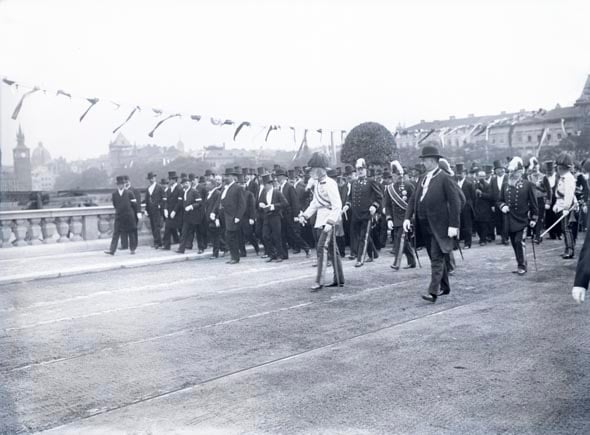
Emperor Franz Joseph I visiting Prague and opening the new Emperor Francis I. Bridge in 1901
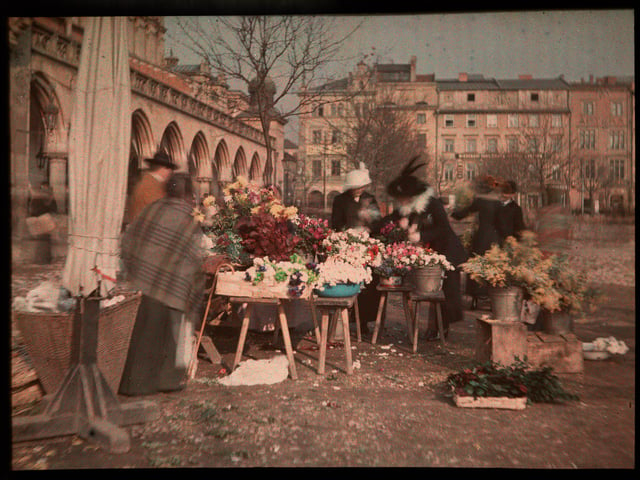
Kraków, a historical Polish city in the Austro-Hungarian Empire where in 1870 authorities allowed the use of the Polish language in the Jagiellonian University
The organization of the administrative system in the Austrian Empire was complicated by the fact that between the State and the purely local communal administration there intruded yet a third element, grounded in history, the territories (Länder). The State administration comprised all affairs having relation to rights, duties and interests "which are common to all territories"; all other administrative tasks were left to the territories. Finally, the communes had self-government within their own sphere.
To this division of the work of administration corresponded a three-fold organization of the authorities: State, territorial and communal. The State authorities were divided on geographical lines into central, intermediate and local, and side by side with this there was a division of the offices for the transaction of business according to the various branches of the administration. The central authorities, which as early as the 18th century worked together in a common mother cell of the State chancery, became differentiated so soon as the growing tasks of administration called for specialization; in 1869 there were seven departments, and in the concluding decade of the Austrian Empire there were set up Ministries of Labour, Food, Public Health and Social Care. Under these ministries came the Statthalter, whose administrative area had ordinarily the proportions of a Crown territory (Kronland); but the immense variations in area of the Crown territories made a uniform and consistent intermediate administrative organization practically impossible. The lowest administrative unit was the political sub-district (Bezirk) under an official (Bezirkshauptmann), who united nearly all the administrative functions which were divided among the various ministries according to their attributions.
Side by side with the State administration certain Crown territory administrations also existed in the 17 Crown territories, carried on by selected honorary officials, having under them a staff of professional officials. Many branches of the territorial administration had great similarities with those of the State, so that their spheres of activity frequently overlapped and came into collision. This administrative "double track", as it was called, led, it is true, in many cases to lively emulation, but was on the whole highly extravagant. The evils of this complicated system are obvious, and easy to condemn. They can be explained, partly by the origin of the State – for the most part through a voluntary union of countries possessed by a strong sense of their own individuality – partly by the influence in Austria of the Germanic spirit, well understood by the Slavs, which has nothing of the Latin tendency to reduce all questions of administration to clear-cut formulae as part of a logically consistent system. Like the English administrative system, the Austrian presented a rich variety, a variety indeed so rich that it clamoured for drastic reform.
Bienerth's last act as premier in May 1911 was the appointment of a commission nominated by the Emperor, to draw up a scheme of administrative reform. So early as 1904 Korber had declared a complete change in the principles of administration to be essential if the machinery of State were to continue working. After seven years of inaction, however, this imperial rescript was pitched in a far lower key. The continuous progress of society, it said, had made increased demands on the administration, that is to say, it was assumed that reform was not demanded so much by the defects of the administration but by the progress of the times, not because the administration was bad, but because life was better. It was an attempt to reform the administration without first reforming the State on equivalent lines.
A reform commission without a programme naturally first occupied itself with reforms about which there was no controversy. After a year had gone by it drew up "Proposals for the training of State officials". After another two years it had indeed brought to light carefully prepared material for study, which was of great scientific value; but its proposals. though politically of importance, did not provide any basis for reform on a large scale. And so when the World War broke out the commission dispersed without practical results, leaving behind it an imposing array of folio volumes of great scientific value. It was not till March 1918 that the Seidler Government decided upon a programme of national autonomy as a basis for administrative reform, which was, however, never carried into effect.[41]
Kingdom of Hungary
Administrative divisions and the counties of Hungary
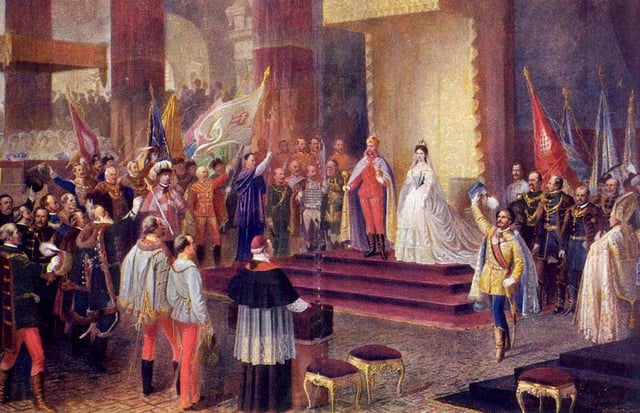
Coronation of Francis Joseph I and Elisabeth Amalie at Matthias Church, Buda, 8 June 1867
From 1867 the administrative and political divisions of the lands belonging to the Hungarian crown were in great measure remodelled. In 1868 Transylvania was definitely reunited to Hungary proper, and the town and district of Fiume declared autonomous. In 1873 part of the "Military Frontier" was united with Hungary proper and part with Croatia-Slavonia. Hungary proper, according to ancient usage, was generally divided into four great divisions or circles, and Transylvania up to 1876 was regarded as the fifth. In 1876 a general system of counties was introduced. According to this division Hungary proper is divided into seven circles, of which Transylvania forms one. The whole country is divided into the following counties:
(a) The circle on the left bank of the Danube contains eleven counties: (1) Árva, (2) Bars, (3) Esztergom, (4) Hont, (5) Liptó, (6) Nógrád, (7) Nyitra, (8) Pozsony (9) Trencsén, (10) Túrócz and (11) Zólyom.
(b) The circle on the right bank of the Danube contains eleven counties: Baranya, Fejér, Győr, Komárom, Moson, Somogy, Sopron, Tolna, Vas, Veszprém and Zala.
(c) The circle between the Danube and Tisza contains five counties: Bács-Bodrog, Csongrád, Heves, Jász-Nagykun-Szolnok and Pest-Pilis-Solt-Kiskun.
(d) The circle on the right bank of the Tisza contains eight counties: Abaúj-Torna, Bereg, Borsod, Gömör-es Kis-Hont, Sáros, Szepes, Ung, Zemplén.
(e) The circle on the left bank of the Tisza contains eight counties: Békés, Bihar, Hajdú, Máramaros, Szabolcs, Szatmár, Szilágy and Ugocsa.
(f) The circle between the Tisza and the Maros contains five counties: Arad, Csanád, Krassó-Szörény, Temes and Torontál.
(g) Transylvania contains fifteen counties: Also-Fehér, Besztercze-Naszód, Brassó, Csík, Fogaras, Háromszek, Hunyad, Kis-Küküllő, Kolozs, Maros-Torda, Nagy-Küküllő, Szeben, Szolnok-Doboka, Torda-Aranyos and Udvarhely.
Fiume town and district forms a separate division.
Croatia-Slavonia is divided into eight counties: Bjelovar-Križevci, Lika-Krbava, Modrus-Fiume, Pozega, Srijemska, Varaždin, Virovitica and Zagreb.
Municipal rights of the biggest cities in Hungary
In regard to local government, the country was divided into municipalities or counties, which possessed a certain amount of self-government. Hungary proper was divided into sixty-three rural, and—including Fiume—twenty-six urban municipalities (see section on Administrative Divisions). These urban municipalities were towns which for their local government were independent of the counties in which they were situated, and have, therefore, a larger amount of municipal autonomy than the communes or the other towns. The administration of the municipalities is carried on by an official appointed by the king, aided by a representative body. Since 1876 each municipality had a council of twenty members to exercise control over its administration. According to this division Hungary proper is divided into seven circles.[29]
Besides these sixty-three rural counties for Hungary, and eight for Croatia-Slavonia, Hungary had twenty-six urban counties or towns with municipal rights. These were: Arad, Baja, Debreczen, Győr, Hódmezővásárhely, Kassa, Kecskemét, Kolozsvár, Komárom, Marosvásárhely, Nagyvárad, Pancsova, Pécs, Pozsony, Selmecz- és Bélabanya, Sopron, Szabadka, Szatmárnémeti, Szeged, Székesfehervár, Temesvár, Újvidék, Versecz, Zombor, the town of Fiume and Budapest, the capital of the country.[29]
In Croatia-Slavonia there are four urban counties or towns with municipal rights namely: Osijek, Varaždin and Zagreb and Zemun.[29]
Politics
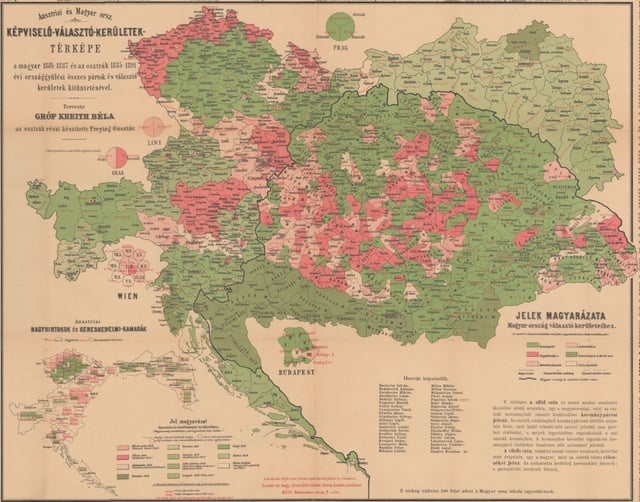
Electoral districts of Austria and Hungary in the 1880s. On the map opposition districts are marked in different shades of red, ruling party districts are in different shades of green, independent districts are in white.
The first prime minister of Hungary after the Compromise was Count Gyula Andrássy (1867–1871). The old Hungarian Constitution was restored, and Franz Joseph was crowned as King of Hungary. Andrássy next served as the Foreign Minister of Austria-Hungary (1871–1879).
The Empire relied increasingly on a cosmopolitan bureaucracy—in which Czechs played an important role—backed by loyal elements, including a large part of the German, Hungarian, Polish and Croat aristocracy.[42]
Political struggles in the Empire

Demonstration for universal right to vote in Prague, Bohemia, 1905
The traditional aristocracy and land-based gentry class gradually faced increasingly wealthy men of the cities, who achieved wealth through trade and industrialization. The urban middle and upper class tended to seek their own power and supported progressive movements in the aftermath of revolutions in Europe.
As in the German Empire, the Austro-Hungarian Empire frequently used liberal economic policies and practices. From the 1860s, businessmen succeeded in industrializing parts of the Empire. Newly prosperous members of the bourgeoisie erected large homes, and began to take prominent roles in urban life that rivaled the aristocracy's. In the early period, they encouraged the government to seek foreign investment to build up infrastructure, such as railroads, in aid of industrialization, transportation and communications, and development.
The influence of liberals in Austria, most of them ethnic Germans, weakened under the leadership of Count Eduard von Taaffe, the Austrian prime minister from 1879 to 1893. Taaffe used a coalition of clergy, conservatives and Slavic parties to weaken the liberals. In Bohemia, for example, he authorized Czech as an official language of the bureaucracy and school system, thus breaking the German speakers' monopoly on holding office. Such reforms encouraged other ethnic groups to push for greater autonomy as well. By playing nationalities off one another, the government ensured the monarchy's central role in holding together competing interest groups in an era of rapid change.
During the First World War, rising national sentiments and labour movements contributed to strikes, protests and civil unrest in the Empire. After the war, republican, national parties contributed to the disintegration and collapse of the monarchy in Austria and Hungary. Republics were established in Vienna and Budapest.[43]
Legislation to help the working class emerged from Catholic conservatives. They turned to social reform by using Swiss and German models and intervening in private industry. In Germany Chancellor Otto von Bismarck had used such policies to neutralize socialist promises. The Catholics studied the Swiss Factory Act of 1877 that limited working hours for everyone, and gave maternity benefits, and German laws that insured workers against industrial risks inherent in the workplace. These served as the basis for Austria's 1885 Trade Code Amendment.[44]
Heavy dominance of ethnic minority elected liberal parties in the Hungarian Parliament
The Austro-Hungarian compromise and its supporting parliamentary parties remained bitterly unpopular among the ethnic Hungarian voters, and the continuous successes of the pro-compromise liberal parties in the Hungarian parliamentary elections caused long lasting frustration among Hungarian voters. The ethnic minorities had the key-role in the political maintenance of the compromise in Hungary, because they were able to vote the pro-compromise liberal parties into the position of the majority/ruling parties of the Hungarian parliament. The pro-compromise liberal parties were the most popular among ethnic minority voters, however the Slovak Serb Romanian minority parties have remained unpopular among the ethnic minorities. The nationalist Hungarian parties - which were supported by the overwhelming majority of ethnic Hungarian voters - have always remained in the opposition. The only short exception was the 1906-1910 period, where the Hungarian supported nationalist parties could form government.[45]
Ethnic relations

Ethno-linguistic map of Austria-Hungary, 1910
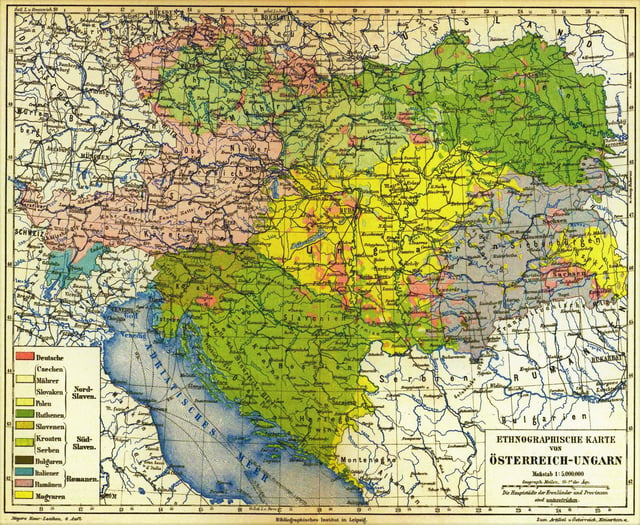
Meyers Konversations-Lexikon ethnographic map of Austria-Hungary, 1885

Literacy in Austria-Hungary (census 1880)

Literacy in Hungary by counties in 1910 (excluding Croatia)

Physical map of Austria-Hungary in 1914
In July 1849, the Hungarian Revolutionary Parliament proclaimed and enacted ethnic and minority rights (the next such laws were in Switzerland), but these were overturned after the Russian and Austrian armies crushed the Hungarian Revolution. After the Kingdom of Hungary reached the Compromise with the Habsburg Dynasty in 1867, one of the first acts of its restored Parliament was to pass a Law on Nationalities (Act Number XLIV of 1868). It was a liberal piece of legislation, and offered extensive language and cultural rights. It did not recognize non-Hungarians to have rights to form states with any territorial autonomy.[46]
The "Austro-Hungarian Compromise of 1867" created the personal union of the independent states of Hungary and Austria, linked under a common monarch also having joint institutions. The Hungarian majority asserted more of their identity within the Kingdom of Hungary, and it came to conflict with some of her own minorities. The imperial power of German speakers who controlled the Austrian half was resented by others. In addition, the emergence of nationalism in the newly independent Romania and Serbia also contributed to ethnic issues in the empire.
Article 19 of the 1867 "Basic State Act" (Staatsgrundgesetz), valid only for the Cisleithanian (Austrian) part of Austria-Hungary,[47] said:
All races of the empire have equal rights, and every race has an inviolable right to the preservation and use of its own nationality and language. The equality of all customary languages ("landesübliche Sprachen") in school, office and public life, is recognized by the state. In those territories in which several races dwell, the public and educational institutions are to be so arranged that, without applying compulsion to learn a second country language ("Landessprache"), each of the races receives the necessary means of education in its own language.[48]
The implementation of this principle led to several disputes, as it was not clear which languages could be regarded as "customary". The Germans, the traditional bureaucratic, capitalist and cultural elite, demanded the recognition of their language as a customary language in every part of the empire. German nationalists, especially in the Sudetenland (part of Bohemia), looked to Berlin in the new German Empire.[49] There was a German-speaking element in Austria proper (west of Vienna), but it did not display much sense of German nationalism. That is, it did not demand an independent state; rather it flourished by holding most of the high military and diplomatic offices in the Empire.
Italian was regarded as an old "culture language" (Kultursprache) by German intellectuals and had always been granted equal rights as an official language of the Empire, but the Germans had difficulty in accepting the Slavic languages as equal to their own. On one occasion Count A. Auersperg (Anastasius Grün) entered the Diet of Carniola carrying what he claimed to be the whole corpus of Slovene literature under his arm; this was to demonstrate that the Slovene language could not be substituted for German as the language of higher education.
The following years saw official recognition of several languages, at least in Austria. From 1867, laws awarded Croatian equal status with Italian in Dalmatia. From 1882, there was a Slovene majority in the Diet of Carniola and in the capital Laibach (Ljubljana); they replaced German with Slovene as their primary official language. Galicia designated Polish instead of German in 1869 as the customary language of government.
The language disputes were most fiercely fought in Bohemia, where the Czech speakers formed a majority and sought equal status for their language to German. The Czechs had lived primarily in Bohemia since the 6th century and German immigrants had begun settling the Bohemian periphery in the 13th century. The constitution of 1627 made the German language a second official language and equal to Czech. German speakers lost their majority in the Bohemian Diet in 1880 and became a minority to Czech speakers in the cities of Prague and Pilsen (while retaining a slight numerical majority in the city of Brno (Brünn)). The old Charles University in Prague, hitherto dominated by German speakers, was divided into German and Czech-speaking faculties in 1882.
At the same time, Hungarian dominance faced challenges from the local majorities of Romanians in Transylvania and in the eastern Banat, Slovaks in today's Slovakia, and Croats and Serbs in the crown lands of Croatia and of Dalmatia (today's Croatia), in Bosnia and Herzegovina, and in the provinces known as the Vojvodina (today's northern Serbia). The Romanians and the Serbs began to agitate for union with their fellow nationalists and language speakers in the newly founded states of Romania (1859–1878) and Serbia.
Hungary's leaders were generally less willing than their Austrian counterparts to share power with their subject minorities, but they granted a large measure of autonomy to Croatia in 1868. To some extent, they modeled their relationship to that kingdom on their own compromise with Austria of the previous year. In spite of nominal autonomy, the Croatian government was an economic and administrative part of Hungary, which the Croatians resented. In the Kingdom of Croatia-Slavonia and Bosnia and Herzegovina many advocated the idea of a trialist Austro-Hungaro-Croatian monarchy; among the supporters of the idea were Archduke Leopold Salvator, Archduke Franz Ferdinand and emperor and king Charles I who during his short reign supported the trialist idea only to be vetoed by the Hungarian government and Count Istvan Tisza. The count finally signed the trialist proclamation after heavy pressure from the king on 23 October 1918.[50]
Language was one of the most contentious issues in Austro-Hungarian politics. All governments faced difficult and divisive hurdles in deciding on the languages of government and of instruction. The minorities sought the widest opportunities for education in their own languages, as well as in the "dominant" languages—Hungarian and German. By the "Ordinance of 5 April 1897", the Austrian Prime Minister Count Kasimir Felix Badeni gave Czech equal standing with German in the internal government of Bohemia; this led to a crisis because of nationalist German agitation throughout the empire. The Crown dismissed Badeni.
The Hungarian Minority Act of 1868 gave the minorities (Slovaks, Romanians, Serbs, et al.) individual (but not also communal) rights to use their language in offices, schools (although in practice often only in those founded by them and not by the state), courts and municipalities (if 20% of the deputies demanded it). From June 1907, all public and private schools in Hungary were obliged to ensure that after the fourth grade, the pupils could express themselves fluently in Hungarian. This led to the closing of several minority schools, devoted mostly to the Slovak and Rusyn languages.
The two kingdoms sometimes divided their spheres of influence. According to Misha Glenny in his book, The Balkans, 1804–1999, the Austrians responded to Hungarian support of Czechs by supporting the Croatian national movement in Zagreb.
In recognition that he reigned in a multi-ethnic country, Emperor Franz Joseph spoke (and used) German, Hungarian and Czech fluently, and Croatian, Serbian, Polish and Italian to some degree.
Jews
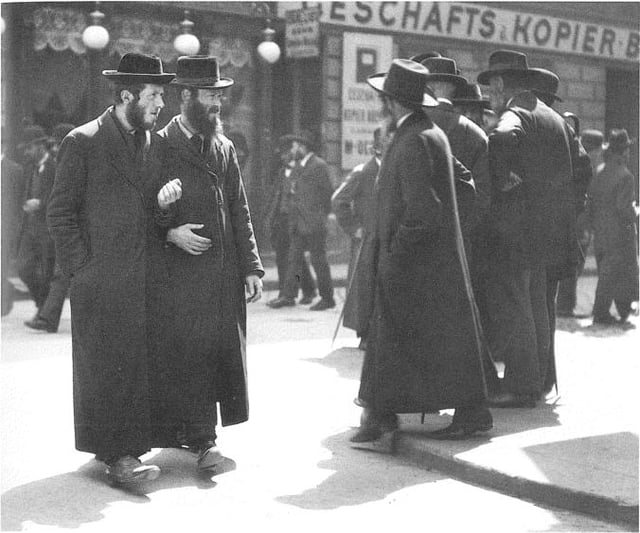
Orthodox Jews from Galicia in Leopoldstadt, Vienna, 1915
Around 1900, Jews numbered about two million in the whole territory of the Austro-Hungarian Empire;[51] their position was ambiguous. Antisemitic parties and movements existed, but the governments of Vienna and Budapest did not initiate pogroms or implement official antisemitic policies. They feared that such ethnic violence could ignite other ethnic minorities and escalate out of control. The antisemitic parties remained on the periphery of the political sphere due to their low popularity among voters in the parliamentary elections.
In that period, the majority of Jews in Austria-Hungary lived in small towns (shtetls) in Galicia and rural areas in Hungary and Bohemia; however, they had large communities and even local majorities in the downtown districts of Vienna, Budapest and Prague. Of the pre-World War I military forces of the major European powers, the Austro-Hungarian army was almost alone in its regular promotion of Jews to positions of command.[52] While the Jewish population of the lands of the Dual Monarchy was about five percent, Jews made up nearly eighteen percent of the reserve officer corps.[53] Thanks to the modernity of the constitution and to the benevolence of emperor Franz Joseph, the Austrian Jews came to regard the era of Austria-Hungary as a golden era of their history.[54] By 1910 about 900,000 religious Jews made up approximately 5% of the population of Hungary and about 23% of Budapest's citizenry. Jews accounted for 54% of commercial business owners, 85% of financial institution directors and owners in banking, and 62% of all employees in commerce,[55] 20% of all general grammar school students, and 37% of all commercial scientific grammar school students, 31.9% of all engineering students, and 34.1% of all students in human faculties of the universities. Jews were accounted for 48.5% of all physicians,[56] and 49.4% of all lawyers/jurists in Hungary.[57] Note: The numbers of Jews were reconstructed from religious censuses. They did not include the people of Jewish origin who had converted to Christianity, or the number of atheists. Among many Hungarian parliament members of Jewish origin, the most famous Jewish members in Hungarian political life were Vilmos Vázsonyi as Minister of Justice, Samu Hazai as Minister of War, János Teleszky as minister of finance and János Harkányi as minister of trade, and József Szterényi as minister of trade.
Foreign policy
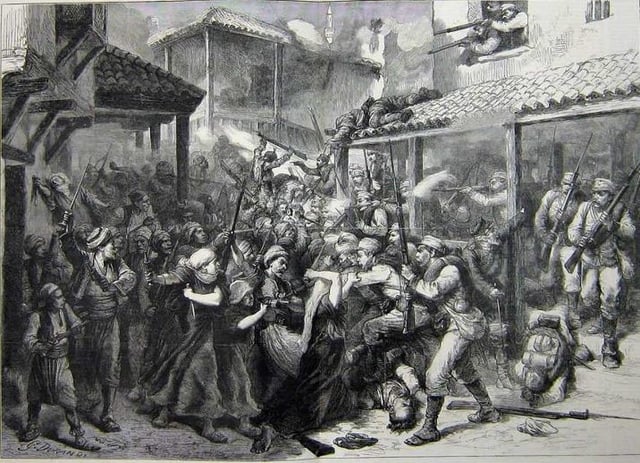
Bosnian Muslim resistance during the battle of Sarajevo in 1878 against the Austro-Hungarian occupation
The minister of foreign affairs conducted the foreign relations of the Dual Monarchy, and negotiated treaties.[58]
The Dual Monarchy was created in the wake of a losing war in 1866 with Prussia and Italy. To rebuild Habsburg prestige and gain revenge against Prussia, Count Friedrich Ferdinand von Beust became foreign secretary. He hated Prussia's diplomat, Otto von Bismarck, who had repeatedly outmaneuvered him. Beust looked to France and negotiated with Emperor Napoleon III and Italy for an anti-Prussian alliance. No terms could be reached. The decisive victory of Prusso-German armies in the war of 1870 with France and the founding of the German Empire ended all hope of revenge and Beust retired.[59]
After being forced out of Germany and Italy, the Dual Monarchy turned to the Balkans, which were in tumult as nationalistic efforts were trying to end the rule of the Ottomans. Both Russia and Austria-Hungary saw an opportunity to expand in this region. Russia in particular took on the role of protector of Slavs and Orthodox Christians. Austria envisioned a multi-ethnic, religiously diverse empire under Vienna's control. Count Gyula Andrássy, a Hungarian who was Foreign Minister (1871 to 1879), made the centerpiece of his policy one of opposition to Russian expansion in the Balkans and blocking Serbian ambitions to dominate a new South Slav federation. He wanted Germany to ally with Austria, not Russia.[60]
When Russia defeated Turkey in a war the resulting Treaty of San Stefano was seen in Austria as much too favourable for Russia and its Orthodox-Slavic goals. The Congress of Berlin in 1878 let Austria occupy (but not annex) the province of Bosnia and Herzegovina, a predominantly Slavic area. In 1914, Slavic militants in Bosnia rejected Austria's plan to fully absorb the area; they assassinated the Austrian heir and precipitated World War I.[61]
Economy
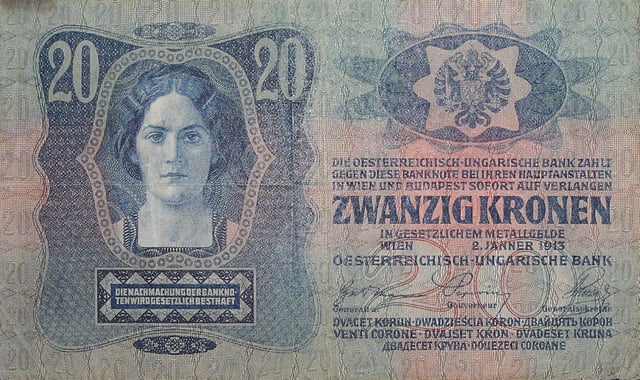
A 20-crown banknote of the Dual Monarchy, using all official and recognized languages except Hungarian
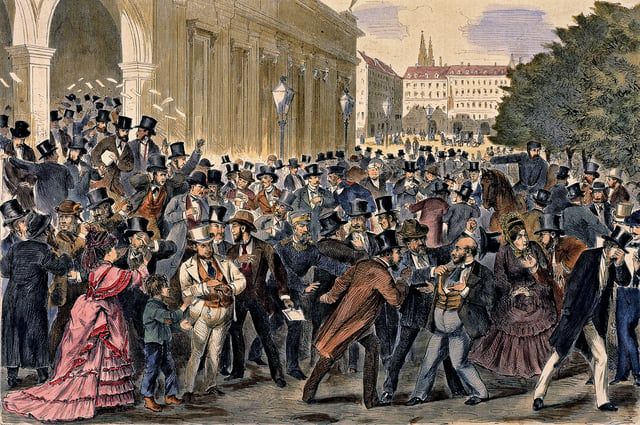
Black Friday, 9 May 1873, Vienna Stock Exchange. The Panic of 1873 and Long Depression followed.
The Austro-Hungarian economy changed dramatically during the Dual Monarchy. The capitalist way of production spread throughout the Empire during its 50-year existences. Technological change accelerated industrialization and urbanization. The first Austrian stock exchange (the Wiener Börse) was opened in 1771 in Vienna, the first stock exchange of the Kingdom of Hungary (the Budapest Stock Exchange) was opened in Budapest in 1864. The central bank (Bank of issue) was founded as Austrian National Bank in 1816. In 1878, it transformed into Austro-Hungarian National Bank with principal offices in both Vienna and Budapest.[62] The central bank was governed by alternating Austrian or Hungarian governors and vice-governors.[63]
The gross national product per capita grew roughly 1.76% per year from 1870 to 1913. That level of growth compared very favorably to that of other European nations such as Britain (1%), France (1.06%), and Germany (1.51%).[64] However, in a comparison with Germany and Britain, the Austro-Hungarian economy as a whole still lagged considerably, as sustained modernization had begun much later. Like the German Empire, that of Austria-Hungary frequently employed liberal economic policies and practices. In 1873, the old Hungarian capital Buda and Óbuda (Ancient Buda) were officially merged with the third city, Pest, thus creating the new metropolis of Budapest. The dynamic Pest grew into Hungary's administrative, political, economic, trade and cultural hub. Many of the state institutions and the modern administrative system of Hungary were established during this period. Economic growth centered on Vienna and Budapest, the Austrian lands (areas of modern Austria), the Alpine region and the Bohemian lands. In the later years of the 19th century, rapid economic growth spread to the central Hungarian plain and to the Carpathian lands. As a result, wide disparities of development existed within the empire. In general, the western areas became more developed than the eastern. The Kingdom of Hungary became the world's second largest flour exporter after the United States.[65] The large Hungarian food exports were not limited to neighbouring Germany and Italy: Hungary became the most important foreign food supplier of the large cities and industrial centres of the United Kingdom.[66]
However, by the end of the 19th century, economic differences gradually began to even out as economic growth in the eastern parts of the monarchy consistently surpassed that in the western. The strong agriculture and food industry of the Kingdom of Hungary with the centre of Budapest became predominant within the empire and made up a large proportion of the export to the rest of Europe. Meanwhile, western areas, concentrated mainly around Prague and Vienna, excelled in various manufacturing industries. This division of labour between the east and west, besides the existing economic and monetary union, led to an even more rapid economic growth throughout Austria-Hungary by the early 20th century. However, since the turn of the twentieth century, the Austrian half of the Monarchy could preserve its dominance within the empire in the sectors of the first industrial revolution, but Hungary had a better position in the industries of the second industrial revolution, in these modern sectors of the second industrial revolution the Austrian competition could not become dominant.[67]
The empire's heavy industry had mostly focused on machine building, especially for the electric power industry, locomotive industry and automotive industry, while in light industry the precision mechanics industry was the most dominant. Through the years leading up to World War I the country became the 4th biggest machine manufacturer in the world.[68]
The two most important trading partners were traditionally Germany (1910: 48% of all exports, 39% of all imports), and Great Britain (1910: almost 10% of all exports, 8% of all imports), the third most important partner was the United States, it followed by Russia, France, Switzerland, Romania, the Balkan states and South America.[8] Trade with the geographically neighbouring Russia, however, had a relatively low weight (1910: 3% of all exports /mainly machinery for Russia, 7% of all imports /mainly raw materials from Russia).
Automotive industry
Prior to World War I, the Austrian Empire had five car manufacturer companies. These were: Austro-Daimler in Wiener-Neustadt (cars trucks, buses),[69] Gräf & Stift in Vienna (cars),[70] Laurin & Klement in Mladá Boleslav (motorcycles, cars),[71] Nesselsdorfer in Nesselsdorf (Kopřivnice), Moravia (automobiles), and Lohner-Werke in Vienna (cars).[72] Austrian car production started in 1897.
Prior to World War I, the Kingdom of Hungary had four car manufacturer companies. These were: the Ganz company[73][74] in Budapest, RÁBA Automobile[75] in Győr, MÁG (later Magomobil)[76][77] in Budapest, and MARTA (Hungarian Automobile Joint-stock Company Arad)[78] in Arad. Hungarian car production started in 1900. Automotive factories in the Kingdom of Hungary manufactured motorcycles, cars, taxicabs, trucks and buses.
Aeronautic industry
The first airplane in Austria was Edvard Rusjan's design, the Eda I, which had its maiden flight in the vicinity of Gorizia on 25 November 1909.[79]
The first Hungarian hydrogen filled experimental balloons were built by István Szabik and József Domin in 1784. The first Hungarian designed and produced airplane (powered by Hungarian built inline engine) was flown at Rákosmező on 4 November[80] 1909.[81] The earliest Hungarian radial engine powered airplane was built in 1913. Between 1913 and 1918, the Hungarian aircraft industry began developing. The three greatest: UFAG Hungarian Aircraft Factory (1914), Hungarian General Aircraft Factory (1916), Hungarian Lloyd Aircraft, Engine Factory at Aszód (1916),[82] and Marta in Arad (1914).[83] During the First World War, fighter planes, bombers and reconnaissance planes were produced in these factories. The most important aeroengine factories were Weiss Manfred Works, GANZ Works, and Hungarian Automobile Joint-stock Company Arad.
Locomotive engine and railway vehicle manufacturers
The locomotive (steam engines and wagons, bridge and iron structures) factories were installed in Vienna (Locomotive Factory of the State Railway Company, founded in 1839), in Wiener Neustadt (New Vienna Locomotive Factory, founded in 1841), and in Floridsdorf (Floridsdorf Locomotive Factory, founded in 1869).[84][85][86]
The Hungarian Locomotive (engines and wagons bridge and iron structures) factories were the MÁVAG company in Budapest (steam engines and wagons) and the Ganz company in Budapest (steam engines, wagons, the production of electric locomotives and electric trams started from 1894).[87] and the RÁBA Company in Győr.
Poverty
Galicia has been described as the poorest province of Austro-Hungary. The near constant famines in Galicia, resulting in 50,000 deaths a year, have been described as endemic.[88]
Infrastructure
Transport
Railways
By 1913, the combined length of the railway tracks of the Austrian Empire and Kingdom of Hungary reached 43,280 kilometres (26,890 miles). In Western Europe only Germany had more extended railway network (63,378 km, 39,381 mi); the Austro-Hungarian Empire was followed by France (40,770 km, 25,330 mi), the United Kingdom (32,623 km, 20,271 mi), Italy (18,873 km, 11,727 mi) and Spain (15,088 km, 9,375 mi).[89]
Railway network of the Austrian Empire
Rail transport expanded rapidly in the Austro-Hungarian Empire. Its predecessor state, the Habsburg Empire, had built a substantial core of railways in the west, originating from Vienna, by 1841. Austria's first steam railway from Vienna to Moravia with its terminus in Galicia (Bochnie) was opened in 1839. The first train travelled from Vienna to Lundenburg (Břeclav) on 6 June 1839 and one month later between the imperial capital in Vienna and the capital of Moravia Brünn (Brno) on 7 July. At that point, the government realized the military possibilities of rail and began to invest heavily in construction. Pozsony (Bratislava), Budapest, Prague, Kraków, Graz, Laibach (Ljubljana) and Venedig (Venice) became linked to the main network. By 1854, the empire had almost 2,000 km (1,200 mi) of track, about 60–70% of it in state hands. The government then began to sell off large portions of track to private investors to recoup some of its investments and because of the financial strains of the 1848 Revolution and of the Crimean War.
From 1854 to 1879, private interests conducted almost all rail construction. What would become Cisleithania gained 7,952 km (4,941 mi) of track, and Hungary built 5,839 km (3,628 mi) of track. During this time, many new areas joined the railway system and the existing rail networks gained connections and interconnections. This period marked the beginning of widespread rail transportation in Austria-Hungary, and also the integration of transportation systems in the area. Railways allowed the empire to integrate its economy far more than previously possible, when transportation depended on rivers.
After 1879, the Austrian and the Hungarian governments slowly began to renationalize their rail networks, largely because of the sluggish pace of development during the worldwide depression of the 1870s. Between 1879 and 1900, more than 25,000 km (16,000 mi) of railways were built in Cisleithania and Hungary. Most of this constituted "filling in" of the existing network, although some areas, primarily in the far east, gained rail connections for the first time. The railway reduced transportation costs throughout the empire, opening new markets for products from other lands of the Dual Monarchy. In 1914, of a total of 22,981 km (14,279.73 mi) of railway tracks in Austria, 18,859 km (11,718 mi) (82%) were state owned.
Railway network in the Kingdom of Hungary
The first Hungarian steam locomotive railway line was opened on 15 July 1846 between Pest and Vác.[90] In 1890 most large Hungarian private railway companies were nationalized as a consequence of the poor management of private companies, except the strong Austrian-owned Kaschau-Oderberg Railway (KsOd) and the Austrian-Hungarian Southern Railway (SB/DV). They also joined the zone tariff system of the MÁV (Hungarian State Railways). By 1910, the total length of the rail networks of Hungarian Kingdom reached 22,869 kilometres (14,210 miles), the Hungarian network linked more than 1,490 settlements. Nearly half (52%) of the empire's railways were built in Hungary, thus the railroad density there became higher than that of Cisleithania. This has ranked Hungarian railways the 6th most dense in the world (ahead of countries as Germany or France).[91]
Electrified railway lines of Hungary
Budapest (See: BHÉV):
Ráckeve line (1887),
Szentendre line (1888),
Gödöllő line (1888),
Csepel line (1912)[92]
Metropolitan transit systems
Tramway lines in the cities
Horse-drawn tramways appeared in the first half of the 19th century. Between the 1850s and 1880s many were built. Vienna (1865), Budapest (1866), Brno (1869). Steam trams appeared in the late 1860s. The electrification of tramways started from the late 1880s. The first electrified tramway in Austria-Hungary was built in Budapest in 1887.
Electric tramway lines in the Austrian Empire:
Austria: Gmunden (1894); Linz, Vienna (1897); Graz (1898); Ljubljana (1901); Innsbruck (1905); Unterlach, Ybbs an der Donau (1907); Salzburg (1909); Klagenfurt, Sankt Pölten (1911); Piran (1912)
Austrian Littoral: Pula (1904).
Bohemia: Prague (1891); Teplice (1895); Liberec (1897); Ústí nad Labem, Plzeň, Olomouc (1899); Moravia, Brno, Jablonec nad Nisou (1900); Ostrava (1901); Mariánské Lázně (1902); Budějovice, České Budějovice, Jihlava (1909)
Austrian Silesia: Opava (Troppau) (1905), Cieszyn (Cieszyn) (1911)
Dalmatia: Dubrovnik (1910)
Galicia: Lviv (1894), Bielsko-Biała (1895); Kraków (1901); Tarnów, Cieszyn (1911)[93][94][95]
Electric tramway lines in the Kingdom of Hungary:
Hungary: Budapest (1887); Pressburg/Pozsony/Bratislava (1895); Szabadka/Subotica, Szombathely, Miskolc (1897); Temesvár/Timișoara (1899); Sopron (1900); Szatmárnémeti/Satu Mare (1900); Nyíregyháza (1905); Nagyszeben/Sibiu (1905); Nagyvárad/Oradea (1906); Szeged (1908); Debrecen (1911); Újvidék/Novi Sad (1911); Kassa/Košice (1913); Pécs (1913)
Croatia: Fiume (1899); Pula (1904); Opatija – Lovran (1908); Zagreb (1910); Dubrovnik (1910).[96][97][98][99]
Underground
The Budapest metro Line 1 (originally the "Franz Joseph Underground Electric Railway Company") is the second oldest underground railway in the world[100] (the first being the London Underground's Metropolitan Line and the third being Glasgow), and the first on the European mainland. It was built from 1894 to 1896 and opened on 2 May 1896.[101] In 2002, it was listed as a UNESCO World Heritage Site.[102]
Canals and river regulations
In 1900 the engineer C. Wagenführer drew up plans to link the Danube and the Adriatic Sea by a canal from Vienna to Trieste. It was born from the desire of Austria-Hungary to have a direct link to the Adriatic Sea[103] but was never constructed.
Regulation of the lower Danube and the Iron Gates
In 1831 a plan had already been drafted to make the passage navigable, at the initiative of the Hungarian politician István Széchenyi. Finally Gábor Baross, Hungary's "Iron Minister", succeeded in financing this project. The riverbed rocks and the associated rapids made the gorge valley an infamous passage for shipping. In German, the passage is still known as the Kataraktenstrecke, even though the cataracts are gone. Near the actual "Iron Gates" strait the Prigrada rock was the most important obstacle until 1896: the river widened considerably here and the water level was consequently low. Upstream, the Greben rock near the "Kazan" gorge was notorious.
Regulation of the Tisza River
The length of the Tisza in Hungary used to be 1,419 kilometres (882 miles). It flowed through the Great Hungarian Plain, which is one of the largest flat areas in central Europe. Since plains can cause a river to flow very slowly, the Tisza used to follow a path with many curves and turns, which led to many large floods in the area.
After several small-scale attempts, István Széchenyi organised the "regulation of the Tisza" (Hungarian: a Tisza szabályozása) which started on 27 August 1846, and substantially ended in 1880. The new length of the river in Hungary was 966 km (600 mi) (1,358 km (844 mi) total), with 589 km (366 mi) of "dead channels" and 136 km (85 mi) of new riverbed. The resultant length of the flood-protected river comprises 2,940 km (1,830 mi) (out of 4,220 km (2,620 mi) of all Hungarian protected rivers).
Shipping and ports

Dubrovnik, Kingdom of Dalmatia
The first Hungarian steamship was built by Antal Bernhard in 1817, called S.S. Carolina. It was also the first steamship in Habsburg ruled states.[104] However it was Count István Széchenyi (with the help of Austrian ship's company Erste Donaudampfschiffahrtsgesellschaft (DDSG)), who established the Óbuda Shipyard on the Hungarian Hajógyári Island in 1835, which was the first industrial scale steamship building company in the Habsburg Empire.[105]
The most important seaport was Trieste (today part of Italy), where the Austrian merchant marine was based. Two major shipping companies (Austrian Lloyd and Austro-Americana) and several shipyards were located there. The k.u.k. navy used the port's shipyards to build new ships for the navy. This port grew as Venice declined. From 1815 to 1866, Venice was included within the monarchy: it was prevented from competing with Austrian-ruled ports. The merchant marine did not develop until Venice's shipping interest declined. The navy became significant during the time of the k.u.k. monarchy as industrialization provided sufficient revenues to develop it.
The most important seaport for the Hungarian part of the k.u.k. was Fiume (Rijeka, today part of Croatia), where the Hungarian shipping companies, such as the Adria, operated. The largest Hungarian shipbuilding company was the Ganz-Danubius.
Another significant seaport was Pola (Pula, today part of Croatia) – especially for the navy. In 1889, the Austrian merchant marine consisted of 10,022 ships, with 7,992 fishing vessels. The coast and sea trade had a total of 1,859 sailboats with crews of 6,489 men and a load capacity of 140,838 tons; and 171 steamers with a load capacity of 96,323 tons and a crew of 3,199 men.
The first Danubian steamer company, Donau-Dampfschiffahrt-Gesellschaft (DDSG), was the largest inland shipping company in the world until the collapse of the k.u.k. The Austrian Lloyd was one of the biggest ocean shipping companies of the time. Prior to the beginning of World War I, the company owned 65 middle-sized and large steamers. The Austro-Americana owned one third of them, including the biggest Austrian passenger ship, the SS Kaiser Franz Joseph I. In comparison to the Austrian Lloyd, the Austro-American concentrated on destinations in North and South America.[106][107][108][109][110][111]
Telecommunication
Telegraph
In 1847, the first telegraph connection (Vienna – Brno – Prague) started operation.[112] The first telegraph station on Hungarian territory was opened in December 1847 in Pressburg/ Pozsony /Bratislava/. In 1848, during the Hungarian Revolution, another telegraph centre was built in Buda to connect the most important governmental centres. The first telegraph connection between Vienna and Pest–Buda (later Budapest) was constructed in 1850,[113] and Vienna–Zagreb in 1850.[114] Austria joined a telegraph union with German states.[115]
Austrian Empire
Kingdom of Hungary
Telephone
The first telephone exchange was opened in Zagreb (8 January 1881),[118][119][120] the second was in Budapest (1 May 1881),[121] and the third was opened in Vienna (3 June 1881).[122] Initially telephony was available in the homes of individual subscribers, companies and offices. Public telephone stations appeared in the 1890s, and they quickly became widespread in post offices and railway stations. Austria-Hungary had 568 million telephone calls in 1913; only two Western European countries had more phone calls: the German Empire and the United Kingdom. The Austro-Hungarian Empire was followed by France with 396 million telephone calls and Italy with 230 million phone calls.[123]
Austrian Empire
In 1916, there were 366 million telephone calls in the Austrian half of the monarchy, among them 8.4 million long distant calls.[124]
Kingdom of Hungary
Electronic broadcasting
The Telefon Hírmondó (Telephone Herald) news and entertainment service was introduced in Budapest in 1893. Two decades before the introduction of radio broadcasting, people could listen to political, economic and sport news, cabaret, music and opera in Budapest daily. It operated over a special type of telephone exchange system.
Demographics
The following data is based on the official Austro-Hungarian census conducted in 1910.
Population and area
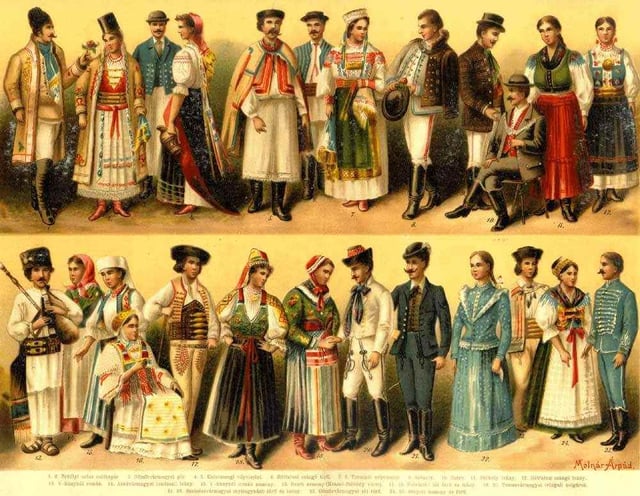
Traditional costumes in Hungary, late 19th century
| Area | Territory (km2) | Population |
|---|---|---|
| Empire of Austria | 300,005 (≈48% of Austria-Hungary) | 28,571,934 (≈57.8% of Austria-Hungary) |
| Kingdom of Hungary | 325,411 (≈52% of Austria-Hungary) | 20,886,487 (≈42.2% of Austria-Hungary) |
| Bosnia & Herzegovina | 51,027 | 1,931,802 |
| Sandžak (occupied until 1909)[125] | 8,403 | 135,000 |
Languages
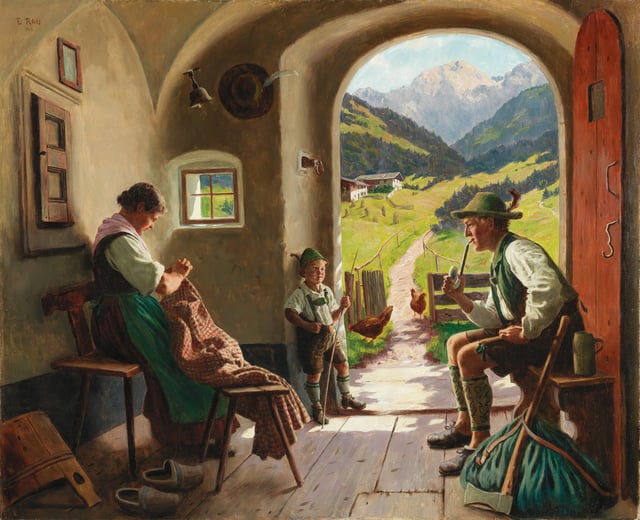
Traditional costumes of Tyrol
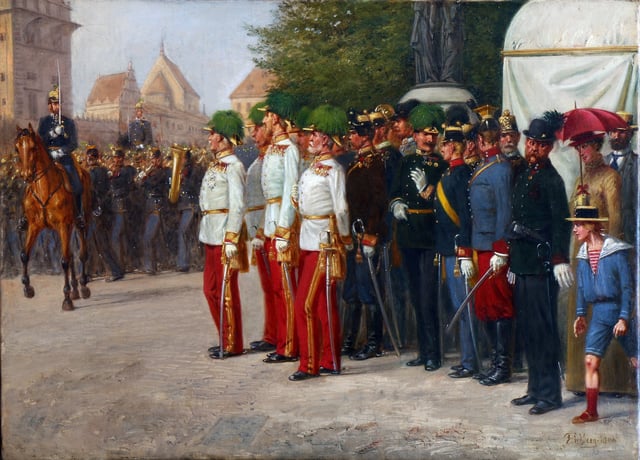
Parade in Prague, Kingdom of Bohemia, 1900
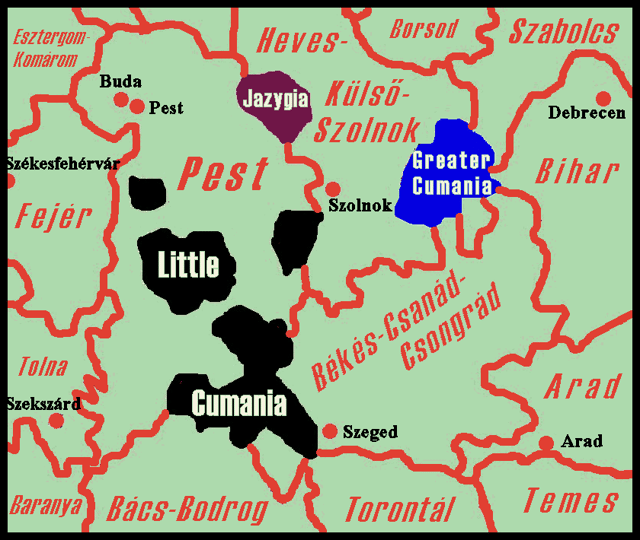
Cumans and Jasz people preserved their regional autonomy (Cumania and Jazygia) until 1876.
In Austria (Cisleithania), the census of 1910 recorded Umgangssprache, everyday language. Jews and those using German in offices often stated German as their Umgangssprache, even when having a different Muttersprache. 36.8% of the total population spoke German as their native language, and more than 71% of the inhabitants spoke some German.
In Hungary (Transleithania), the census was based primarily on mother tongue,[126][127] 48.1% of the total population spoke Hungarian as their native language. Not counting autonomous Croatia-Slavonia, more than 54.4% of the inhabitants of the Kingdom of Hungary were native speakers of Hungarian (this included also the Jews – around 5% of the population -, as mostly they were Hungarian-speaking).[128][129]
Note that some languages were considered dialects of more widely spoken languages. For example: in the census, Rhaeto-Romance languages were counted as "Italian". Yiddish was counted as "German" in both Austria and Hungary.
| Land | Most common language | Other languages (more than 2%) | ||||||
|---|---|---|---|---|---|---|---|---|
| Bohemia | 63.2% | Czech | 36.45% (2,467,724) | German | ||||
| Dalmatia | 96.2% | Serbo-Croatian | 2.8% | Italian | ||||
| Galicia | 58.6% | Polish | 40.2% | Ukrainian | 1.1% | German | ||
| Lower Austria | 95.9% | German | 3.8% | Czech | ||||
| Upper Austria | 99.7% | German | 0.2% | Czech | ||||
| Bukovina | 38.4% | Ukrainian | 34.4% | Romanian | 21.2% | German | 4.6% | Polish |
| Carinthia | 78.6% | German | 21.2% | Slovene | ||||
| Carniola | 94.4% | Slovene | 5.4% | German | ||||
| Salzburg | 99.7% | German | 0.1% | Czech | ||||
| Silesia | 43.9% | German | 31.7% | Polish | 24.3% | Czech | ||
| Styria | 70.5% | German | 29.4% | Slovene | ||||
| Moravia | 71.8% | Czech | 27.6% | German | 0.6% | Polish | ||
| Gorizia and Gradisca | 59.3% | Slovene | 34.5% | Italian | 1.7% | German | ||
| Trieste | 51.9% | Italian | 24.8% | Slovene | 5.2% | German | 1.0% | Serbo-Croatian |
| Istria | 41.6% | Serbo-Croatian | 36.5% | Italian | 13.7% | Slovene | 3.3% | German |
| Tyrol | 57.3% | German | 42.1% | Italian | ||||
| Vorarlberg | 95.4% | German | 4.4% | Italian | ||||
| Language | Hungary proper | Croatia-Slavonia | ||
|---|---|---|---|---|
| speakers | % of population | speakers | % of population | |
| Hungarian | 9,944,627 | 54.5% | 105,948 | 4.1% |
| Romanian | 2,948,186 | 16.0% | 846 | <0.1% |
| Slovak | 1,946,357 | 10.7% | 21,613 | 0.8% |
| German | 1,903,657 | 10.4% | 134, 078 | 5.1% |
| Serbian | 461,516 | 2.5% | 644,955 | 24.6% |
| Ruthenian | 464,270 | 2.3% | 8,317 | 0.3% |
| Croatian | 194,808 | 1.1% | 1,638,354 | 62.5% |
| Others and unspecified | 401,412 | 2.2% | 65,843 | 2.6% |
| Total | 18,264,533 | 100% | 2,621,954 | 100% |
Historical regions:
| Region | Mother tongues | Hungarian language | Other languages |
|---|---|---|---|
| Transylvania | Romanian – 2,819,467 (54%) | 1,658,045 (31.7%) | German – 550,964 (10.5%) |
| Upper Hungary | Slovak – 1,688,413 (55.6%) | 881,320 (32.3%) | German – 198,405 (6.8%) |
| Vojvodina | Serbo-Croatian – 601,770 (39.8%) | 425,672 (28.1%) | German – 324,017 (21.4%) Romanian – 75,318 (5.0%) Slovak – 56,690 (3.7%) |
| Transcarpathia | Ruthenian – 330,010 (54.5%) | 185,433 (30.6%) | German – 64,257 (10.6%) |
| Fiume | Italian – 24,212 (48.6%) | 6,493 (13%) |
|
| Burgenland | German – 217,072 (74.4%) | 26,225 (9%) | Croatian – 43,633 (15%) |
| Prekmurje | Slovene – 74,199 (80.4%) – in 1921 | 14,065 (15.2%) – in 1921 | German – 2,540 (2.8%) – in 1921 |
Religion
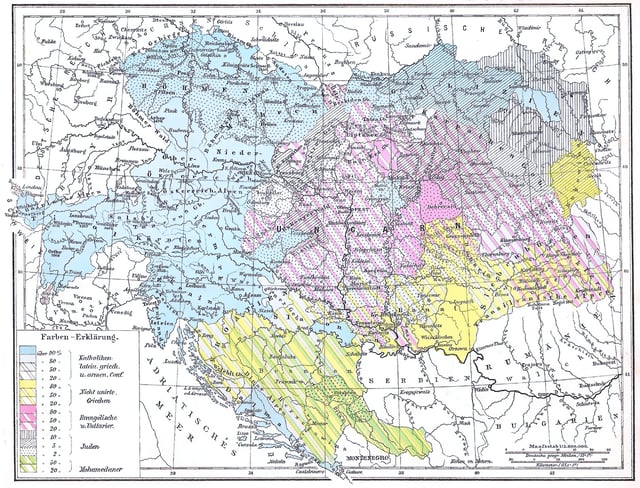
Religions in Austria-Hungary, from the 1881 edition of Andrees Allgemeiner Handatlas. Catholics (both Roman and Uniate) are blue, Protestants purple, Eastern Orthodox yellow, and Muslims green.
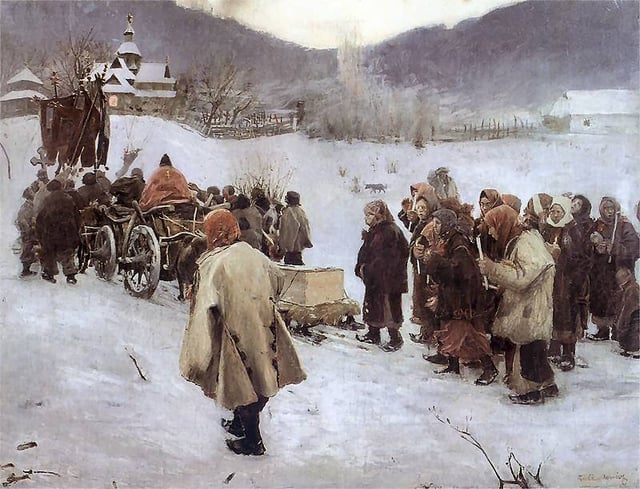
Funeral in Galicia by Teodor Axentowicz, 1882
| Religion | Austria-Hungary | Austria/Cisleithania | Hungary/Transleithania | Bosnia and Herzegovina |
|---|---|---|---|---|
| Catholics (both Roman and Eastern) | 76.6% | 90.9% | 61.8% | 22.9% |
| Protestants | 8.9% | 2.1% | 19.0% | 0% |
| Eastern Orthodox | 8.7% | 2.3% | 14.3% | 43.5% |
| Jews | 4.4% | 4.7% | 4.9% | 0.6% |
| Muslims | 1.3% | 0% | 0% | 32.7% |
Solely in the Empire of Austria:[133]
| Religion | Austria |
|---|---|
| Latin Catholic | 79.1% (20,661,000) |
| Eastern Catholic | 12% (3,134,000) |
| Jewish | 4.7% (1,225,000) |
| Eastern Orthodox | 2.3% (607,000) |
| Lutheran | 1.9% (491,000) |
| Other or no religion | 14,000 |
Solely in the Kingdom of Hungary:[134]
| Religion | Hungary proper & Fiume | Croatia & Slavonia |
|---|---|---|
| Latin Catholic | 49.3% (9,010,305) | 71.6% (1,877,833) |
| Calvinist | 14.3% (2,603,381) | 0.7% (17,948) |
| Eastern Orthodox | 12.8% (2,333,979) | 24.9% (653,184) |
| Eastern Catholic | 11.0% (2,007,916) | 0.7% (17,592) |
| Lutheran | 7.1% (1,306,384) | 1.3% (33,759) |
| Jewish | 5.0% (911,227) | 0.8% (21,231) |
| Unitarian | 0.4% (74,275) | 0.0% (21) |
| Other or no religion | 0.1% (17,066) | 0.0 (386) |
Largest cities
Data: census in 1910[135]
| Rank | Current English name | Contemporary official name[136] | Other | Present-day country | Population in 1910 | Present-day population |
|---|---|---|---|---|---|---|
| Vienna | Wien | Bécs, Beč, Dunaj | Austria | 2,083,630 (city without the suburb 1,481,970) | 1,840,573 (Metro: 2,600,000) | |
| Prague | Prag, Praha | Prága | Czech Republic | 668,000 (city without the suburb 223,741) | 1,301,132 (Metro: 2,620,000) | |
| Trieste | Triest | Trieszt, Trst | Italy | 229,510 | 204,420 | |
| Lviv | Lemberg, Lwów | Ilyvó, Львів, Lvov, Львов | Ukraine | 206,113 | 728,545 | |
| Kraków | Krakau, Kraków | Krakkó, Krakov | Poland | 151,886 | 762,508 | |
| Graz | Grác, Gradec | Austria | 151,781 | 280,020 | ||
| Brno | Brünn, Brno | Berén, Börön, Börénvásár | Czech Republic | 125,737 | 377,028 | |
| Chernivtsi | Czernowitz | Csernyivci, Cernăuți, Чернівці | Ukraine | 87,100 | 242,300 | |
| Plzeň | Pilsen, Plzeň | Pilzen | Czech Republic | 80,343 | 169,858 | |
| Linz | Linec | Austria | 67,817 | 200,841 |
| Rank | Current English name | Contemporary official name[136] | Other | Present-day country | Population in 1910 | Present-day population |
|---|---|---|---|---|---|---|
| Budapest | Budimpešta | Hungary | 1,232,026 (city without the suburb 880,371) | 1,735,711 (Metro: 3,303,786) | ||
| Szeged | Szegedin, Segedin | Hungary | 118,328 | 170,285 | ||
| Subotica | Szabadka | Суботица | Serbia | 94,610 | 105,681 | |
| Debrecen | Hungary | 92,729 | 208,016 | |||
| Zagreb | Zágráb, Agram | Croatia | 79,038 | 790,017 | ||
| Bratislava | Pozsony | Pressburg, Prešporok | Slovakia | 78,223 | 425,167 | |
| Timișoara | Temesvár | Temeswar | Romania | 72,555 | 319,279 | |
| Oradea | Nagyvárad | Großwardein | Romania | 64,169 | 196,367 | |
| Arad | Arad | Romania | 63,166 | 159,074 | ||
| Cluj-Napoca | Kolozsvár | Klausenburg | Romania | 60,808 | 324,576 |
Education
Austrian Empire
Primary and secondary schools
The organization of the Austrian elementary schools was based on the principle of compulsory school attendance, free education, and the imparting of public instruction in the child's own language. Side by side with these existed private schools. The proportion of children attending private schools to those attending the public elementary schools in 1912 was 144,000 to 4.5 millions, i.e. a thirtieth part. Hence the accusation of denationalizing children through the Schulvereine must be accepted with caution. The expenses of education were distributed as follows: the communes built the schoolhouses, the political sub-districts (Bezirke) paid the teachers, the Crown territory gave a grant, and the State appointed the inspectors. Since the State supervised the schools without maintaining them, it was able to increase its demands without being hampered by financial considerations. It is remarkable that the difference between the State educational estimates in Austria and in Hungary was one of 9.3 millions in the former as opposed to 67.6 in the latter. Under Austria, since everywhere that 40 scholars of one nationality were to be found within a radius of 5 km. a school had to be set up in which their language was used, national schools were assured even to linguistic minorities. It is true that this mostly happened at the expense of the German industrial communities, since the Slav labourers as immigrants acquired schools in their own language. The number of elementary schools increased from 19,016 in two to 24,713 in 1913; the number of scholars from 3,490,000 in 1900 to 4,630,000 in 1913.[137]
Universities in Austrian Empire
The first University in the Austrian half of the Empire (Charles University) was founded by H.R. Emperor Charles IV in Prague in 1347. The second oldest university (University of Vienna) was founded by Duke Rudolph IV in 1365.[138]
The higher educational institutions were predominantly German, but beginning in the 1870s, language shifts began to occur.[139] These establishments, which in the middle of the 19th century had had a predominantly German character, underwent in Galicia a conversion into Polish national institutions, in Bohemia and Moravia a separation into German and Czech ones. Thus Germans, Czechs and Poles were provided for. But now the smaller nations also made their voices heard: the Ruthenians, Slovenes and Italians. The Ruthenians demanded at first, in view of the predominantly Ruthenian character of East Galicia, a national partition of the Polish university existing there. Since the Poles were at first unyielding, Ruthenian demonstrations and strikes of students arose, and the Ruthenians were no longer content with the reversion of a few separate professorial chairs, and with parallel courses of lectures. By a pact concluded on 28 January 1914 the Poles promised a Ruthenian university; but owing to the war the question lapsed. The Italians could hardly claim a university of their own on grounds of population (in 19to they numbered 783,000), but they claimed it all the more on grounds of their ancient culture. All parties were agreed that an Italian faculty of laws should be created; the difficulty lay in the choice of the place. The Italians demanded Trieste; but the Government was afraid to let this Adriatic port become the centre of an irredenta; moreover the Southern Slavs of the city wished it kept free from an Italian educational establishment. Bienerth in 1910 brought about a compromise; namely, that it should be founded at once, the situation to be provisionally in Vienna, and to be transferred within four years to Italian national territory. The German National Union (Nationalverband) agreed to extend temporary hospitality to the Italian university in Vienna, but the Southern Slav Hochschule Club demanded a guarantee that a later transfer to the coast provinces should not be contemplated, together with the simultaneous foundation of Slovene professorial chairs in Prague and Cracow, and preliminary steps towards the foundation of a Southern Slav university in Laibach. But in spite of the constant renewal of negotiations for a compromise it was impossible to arrive at any agreement, until the outbreak of war left all the projects for a Ruthenian university at Lemberg, a Slovene one in Laibach, and a second Czech one in Moravia, unrealized.
Kingdom of Hungary
Primary and secondary schools
One of the first measures of newly established Hungarian government was to provide supplementary schools of a non-denominational character. By a law passed in 1868 attendance at school was obligatory for all children between the ages of 6 and 12 years. The communes or parishes were bound to maintain elementary schools, and they were entitled to levy an additional tax of 5% on the state taxes for their maintenance. But the number of state-aided elementary schools was continually increasing, as the spread of the Magyar language to the other races through the medium of the elementary schools was one of the principal concerns of the Hungarian government, and was vigorously pursued. In 1902 there were in Hungary 18,729 elementary schools with 32,020 teachers, attended by 2,573,377 pupils, figures which compare favourably with those of 1877, when there were 15,486 schools with 20,717 teachers, attended by 1,559,636 pupils. In about 61% of these schools the language used was exclusively Magyar, in about 6 20% it was mixed, and in the remainder some non-Magyar language was used. In 1902, 80.56% of the children of school age actually attended school. Since 1891 infant schools, for children between the ages of 3 and 6 years, were maintained either by the communes or by the state.
The public instruction of Hungary contained three other groups of educational institutions: middle or secondary schools, "high schools" and technical schools. The middle schools comprised classical schools (gymnasia) which were preparatory for the universities and other "high schools", and modern schools (Realschulen) preparatory for the technical schools. Their course of study was generally eight years, and they were maintained mostly by the state. The state-maintained gymnasia were mostly of recent foundation, but some schools maintained by the various churches had been in existence for three or sometimes four centuries. The number of middle schools in 1902 was 243 with 4705 teachers, attended by 71,788 pupils; in 1880 their number was 185, attended by 40,747 pupils.
Universities in Kingdom of Hungary
In the year 1276, the university of Veszprém was destroyed by the troops of Péter Csák and it was never rebuilt. A university was established by Louis I of Hungary in Pécs in 1367. Sigismund established a university at Óbuda in 1395. Another, Universitas Istropolitana, was established 1465 in Pozsony (now Bratislava in Slovakia) by Mattias Corvinus. None of these medieval universities survived the Ottoman wars. Nagyszombat University was founded in 1635 and moved to Buda in 1777 and it is called Eötvös Loránd University today. The world's first institute of technology was founded in Selmecbánya, Kingdom of Hungary (since 1920 Banská Štiavnica, now Slovakia) in 1735. Its legal successor is the University of Miskolc in Hungary. The Budapest University of Technology and Economics (BME) is considered the oldest institute of technology in the world with university rank and structure. Its legal predecessor the Institutum Geometrico-Hydrotechnicum was founded in 1782 by Emperor Joseph II.
The high schools included the universities, of which Hungary possessed five, all maintained by the state: at Budapest (founded in 1635), at Kolozsvár (founded in 1872), and at Zagreb (founded in 1874). Newer universities were established in Debrecen in 1912, and Pozsony university was reestablished after a half millennium in 1912. They had four faculties: theology, law, philosophy and medicine (the university at Zagreb was without a faculty of medicine). There were in addition ten high schools of law, called academies, which in 1900 were attended by 1569 pupils. The Polytechnicum in Budapest, founded in 1844, which contained four faculties and was attended in 1900 by 1772 pupils, was also considered a high school. There were in Hungary in 1900 forty-nine theological colleges, twenty-nine Catholic, five Greek Uniat, four Greek Orthodox, ten Protestant and one Jewish. Among special schools the principal mining schools were at Selmeczbánya, Nagyág and Felsőbánya; the principal agricultural colleges at Debreczen and Kolozsvár; and there was a school of forestry at Selmeczbánya, military colleges at Budapest, Kassa, Déva and Zagreb, and a naval school at Fiume. There were in addition a number of training institutes for teachers and a large number of schools of commerce, several art schools – for design, painting, sculpture, music.
Military
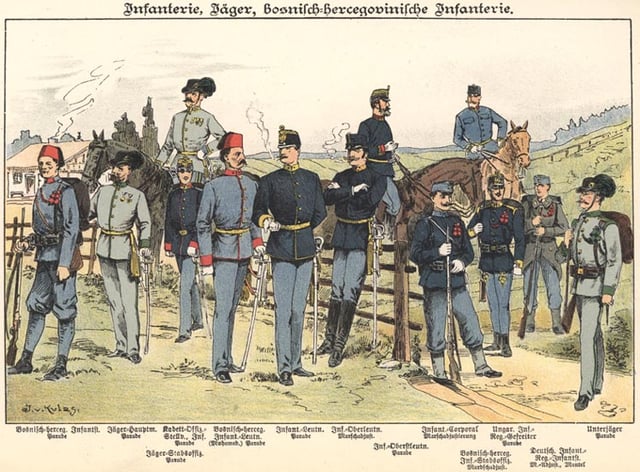
k.u.k. infantry in 1898
The Army was under the command of Archduke Albrecht, Duke of Teschen (1817–1895), an old-fashioned bureaucrat who opposed modernization.[140] The military system of the Austro-Hungarian monarchy was similar in both states, and rested since 1868 upon the principle of the universal and personal obligation of the citizen to bear arms. Its military force was composed of the common army; the special armies, namely the Austrian Landwehr, and the Hungarian Honved, which were separate national institutions, and the Landsturm or levy-en masse. As stated above, the common army stood under the administration of the joint minister of war, while the special armies were under the administration of the respective ministries of national defence. The yearly contingent of recruits for the army was fixed by the military bills voted on by the Austrian and Hungarian parliaments, and was generally determined on the basis of the population, according to the last census returns. It amounted in 1905 to 103,100 men, of which Austria furnished 59,211 men, and Hungary 43,889. Besides 10,000 men were annually allotted to the Austrian Landwehr, and 12,500 to the Hungarian Honved. The term of service was two years (three years in the cavalry) with the colours, seven or eight in the reserve and two in the Landwehr; in the case of men not drafted to the active army the same total period of service was spent in various special reserves.[141]
The common minister of war was the head for the administration of all military affairs, except those of the Austrian Landwehr and of the Hungarian Honved, which were committed to the ministries for national defence of the two respective states. But the supreme command of the army was nominally vested in the monarch, who had the power to take all measures regarding the whole army. In practice the emperor's nephew Archduke Albrecht was his chief military advisor and made the policy decisions.[141]
The Austro-Hungarian navy was mainly a coast defence force, and also included a flotilla of monitors for the Danube. It was administered by the naval department of the ministry of war.[142]
World War I
Preludes: Bosnia and Herzegovina

Recruits from Bosnia-Herzegovina, including Muslim Bosniaks (31%), were drafted into special units of the Austro-Hungarian Army as early as 1879 and were commended for their bravery in service of the Austrian emperor, being awarded more medals than any other unit. The jaunty military march Die Bosniaken Kommen was composed in their honor by Eduard Wagnes.[143]
Russian Pan-Slavic organizations sent aid to the Balkan rebels and so pressured the tsar's government to declare war on the Ottoman Empire in 1877 in the name of protecting Orthodox Christians.[36] Unable to mediate between the Ottoman Empire and Russia over the control of Serbia, Austria-Hungary declared neutrality when the conflict between the two powers escalated into a war. With help from Romania and Greece, Russia defeated the Ottomans and with the Treaty of San Stefano tried to create a large pro-Russian Bulgaria. This treaty sparked an international uproar that almost resulted in a general European war. Austria-Hungary and Britain feared that a large Bulgaria would become a Russian satellite that would enable the tsar to dominate the Balkans. British prime minister Benjamin Disraeli moved warships into position against Russia to halt the advance of Russian influence in the eastern Mediterranean so close to Britain's route through the Suez Canal.[144]
The Congress of Berlin rolled back the Russian victory by partitioning the large Bulgarian state that Russia had carved out of Ottoman territory and denying any part of Bulgaria full independence from the Ottomans. Austria occupied Bosnia and Herzegovina as a way of gaining clout in the Balkans. Serbia, Montenegro and Romania became fully independent. Nonetheless the Balkans remained a site of political unrest with teeming ambition for independence and great power rivalries. At the Congress of Berlin in 1878 Gyula Andrássy (Minister of Foreign Affairs) managed to force Russia to retreat from further demands in the Balkans. As a result, Greater Bulgaria was broken up and Serbian independence was guaranteed.[145] In that year, with Britain's support, Austria-Hungary stationed troops in Bosnia to prevent the Russians from expanding into nearby Serbia. In another measure to keep the Russians out of the Balkans Austria-Hungary formed an alliance, the Mediterranean Entente, with Britain and Italy in 1887 and concluded mutual defence pacts with Germany in 1879 and Romania in 1883 against a possible Russian attack.[146] Following the Congress of Berlin the European powers attempted to guarantee stability through a complex series of alliances and treaties.
Anxious about Balkan instability and Russian aggression, and to counter French interests in Europe, Austria-Hungary forged a defensive alliance with Germany in October 1879 and in May 1882. In October 1882 Italy joined this partnership in the Triple Alliance largely because of Italy's imperial rivalries with France. Tensions between Russia and Austria-Hungary remained high, so Bismarck replaced the League of the Three Emperors with the Reinsurance Treaty with Russia to keep the Habsburgs from recklessly starting a war over Pan-Slavism.[147] The Sandžak-Raška / Novibazar region was under Austro-Hungarian occupation between 1878 and 1909, when it was returned to the Ottoman Empire, before being ultimately divided between kingdoms of Montenegro and Serbia.[148]
On the heels of the Great Balkan Crisis, Austro-Hungarian forces occupied Bosnia and Herzegovina in August 1878 and the monarchy eventually annexed Bosnia and Herzegovina in October 1908 as a common holding of Cisleithania and Transleithania under the control of the Imperial & Royal finance ministry rather than attaching it to either territorial government. The annexation in 1908 led some in Vienna to contemplate combining Bosnia and Herzegovina with Croatia to form a third Slavic component of the monarchy. The deaths of Franz Joseph's brother, Maximilian (1867), and his only son, Rudolf made the Emperor's nephew, Franz Ferdinand, heir to the throne. The Archduke was rumoured to have been an advocate for this trialism as a means to limit the power of the Hungarian aristocracy.[149]
Status of Bosnia-Herzegovina
A proclamation issued on the occasion of its annexation to the Habsburg Monarchy in 1908 promised these lands constitutional institutions, which should secure to their inhabitants full civil rights and a share in the management of their own affairs by means of a local representative assembly. In performance of this promise a constitution was promulgated in 1910. This included a Territorial Statute (Landesstatut) with the setting up of a Territorial Diet, regulations for the election and procedure of the Diet, a law of associations, a law of public meetings, and a law dealing with the district councils. According to this statute Bosnia-Herzegovina formed a single administrative territory under the responsible direction and supervision of the Ministry of Finance of the Dual Monarchy in Vienna. The administration of the country, together with the carrying out of the laws, devolved upon the Territorial Government in Sarajevo, which was subordinate and responsible to the Common Ministry of Finance. The existing judicial and administrative authorities of the Territory retained their previous organization and functions. That statute introduced the modern rights and laws in Bosnia – Herzegovina, and it guaranteed generally the civil rights of the inhabitants of the Territory, namely citizenship, personal liberty, protection by the competent judicial authorities, liberty of creed and conscience, preservation of the national individuality and language, freedom of speech, freedom of learning and education, inviolability of the domicile, secrecy of posts and telegraphs, inviolability of property, the right of petition, and finally the right of holding meetings.[150]
The Diet (Sabor) of Bosnia-Herzegovina set up consisted of a single Chamber, elected on the principle of the representation of interests. It numbered 92 members. Of these 20 consisted of representatives of all the religious confessions, the president of the Supreme Court, the president of the Chamber of Advocates, the president of the Chamber of Commerce, and the mayor of Sarajevo. In addition to these were 72 deputies, elected by three curiae or electoral groups. The first curia included the large landowners, the highest taxpayers, and people who had reached a certain standard of education without regard to the amount they paid in taxes. To the second curia belonged inhabitants of the towns not qualified to vote in the first; to the third, country dwellers disqualified in the same way. With this curial system was combined the grouping of the mandates and of the electors according to the three dominant creeds (Catholic, Serbian Orthodox, Muslim). To the adherents of other creeds the right was conceded of voting with one or other of the religious electoral bodies within the curia to which they belonged.[13]
Sarajevo assassination
On 28 June 1914, Archduke Franz Ferdinand visited the Bosnian capital, Sarajevo. A group of six assassins (Cvjetko Popović, Gavrilo Princip, Muhamed Mehmedbašić, Nedeljko Čabrinović, Trifko Grabež, Vaso Čubrilović) from the nationalist group Mlada Bosna, supplied by the Black Hand, had gathered on the street where the Archduke's motorcade would pass. Čabrinović threw a grenade at the car, but missed. It injured some people nearby, and Franz Ferdinand's convoy could carry on. The other assassins failed to act as the cars drove past them quickly. About an hour later, when Franz Ferdinand was returning from a visit at the Sarajevo Hospital, the convoy took a wrong turn into a street where Gavrilo Princip by coincidence stood. With a pistol, Princip shot and killed Franz Ferdinand and his wife Sophie. The reaction among the Austrian people was mild, almost indifferent. As historian Z. A. B. Zeman later wrote, "the event almost failed to make any impression whatsoever. On Sunday and Monday [June 28 and 29], the crowds in Vienna listened to music and drank wine, as if nothing had happened."[153]
Escalation of violence in Bosnia

Crowds on the streets in the aftermath of the Anti-Serb riots in Sarajevo, 29 June 1914
The assassination excessively intensified the existing traditional religion-based ethnic hostilities in Bosnia. However, in Sarajevo itself, Austrian authorities encouraged[154][155] violence against the Serb residents, which resulted in the Anti-Serb riots of Sarajevo, in which Catholic Croats and Bosnian Muslims killed two and damaged numerous Serb-owned buildings. Writer Ivo Andrić referred to the violence as the "Sarajevo frenzy of hate."[156] Violent actions against ethnic Serbs were organized not only in Sarajevo but also in many other larger Austro-Hungarian cities in modern-day Croatia and Bosnia and Herzegovina.[157] Austro-Hungarian authorities in Bosnia and Herzegovina imprisoned and extradited approximately 5,500 prominent Serbs, 700 to 2,200 of whom died in prison. 460 Serbs were sentenced to death and a predominantly Muslim[158][159][160] special militia known as the Schutzkorps was established and carried out the persecution of Serbs.[161]
Decision for war
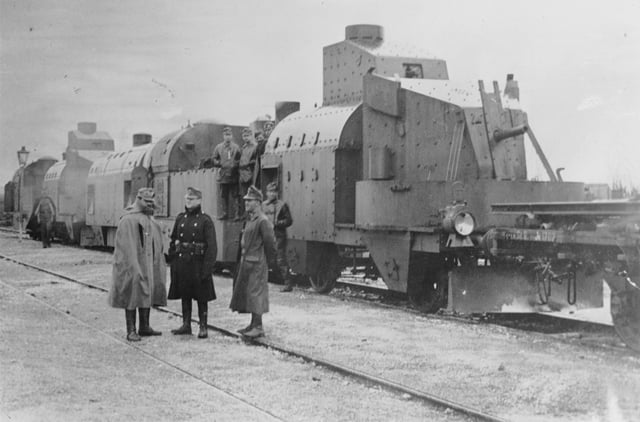
MÁVAG armoured train in 1914
While the empire's military spending had not even doubled since the 1878 Congress of Berlin, Germany's spending had risen fivefold, and the British, Russian, and French expenditures threefold. The empire had lost ethnic Italian areas to Piedmont because of nationalist movements that had swept through Italy, and many Austro-Hungarians perceived as imminent the threat of losing to Serbia the southern territories inhabited by Slavs. Serbia had recently gained considerable territory in the Second Balkan War of 1913, causing much distress in government circles in Vienna and Budapest. Former ambassador and foreign minister Count Alois Aehrenthal had assumed that any future war would be in the Balkan region.
Hungarian prime minister and political scientist István Tisza opposed the expansion of the monarchy in the Balkans (see Bosnian crisis in 1908) because "the Dual Monarchy already had too many Slavs", which would further threaten the integrity of the Dual Monarchy.[162] In March 1914, Tisza wrote a memorandum to Emperor Franz Joseph with a strongly apocalyptic, predictive and embittered tone. He used the hitherto unknown word "Weltkrieg" (meaning World War). "It is my firm conviction that Germany's two neighbors [Russia and France] are carefully proceeding with military preparations, but will not start the war so long as they have not attained a grouping of the Balkan states against us that confronts the monarchy with an attack from three sides and pins down the majority of our forces on our eastern and southern front." [163]
On the day of the assassination of Archduke Franz Ferdinand, Tisza immediately traveled to Vienna where he met Minister of Foreign Affairs Count Leopold Berchtold and Army Commander Count Franz Conrad von Hötzendorf. They proposed to solve the dispute with arms, attacking Serbia. Tisza proposed to give the government of Serbia time to take a stand as to whether it was involved in the organisation of the murder and proposed a peaceful resolution, arguing that the international situation would settle soon. Returning to Budapest, he wrote to Emperor Franz Joseph saying he would not take any responsibility for the armed conflict because there was no proof that Serbia had plotted the assassination. Tisza opposed a war with Serbia, stating (correctly, as it turned out) that any war with the Serbs was bound to trigger a war with Russia and hence a general European war.[164] He did not trust in the Italian alliance, due to the political aftermath of the Second Italian War of Independence. He thought that even a successful Austro-Hungarian war would be disastrous for the integrity of Kingdom of Hungary, where Hungary would be the next victim of Austrian politics. After a successful war against Serbia, Tisza foresaw a possible Austrian military attack against the Kingdom of Hungary, where the Austrians want to break up the territory of Hungary.[165]
Some members of the government, such as Count Franz Conrad von Hötzendorf, had wanted to confront the resurgent Serbian nation for some years in a preventive war, but the Emperor, 84 years old and an enemy of all adventures, disapproved.
The foreign ministry of Austro-Hungarian Empire sent ambassador László Szőgyény to Potsdam, where he inquired about the standpoint of the German Emperor on 5 July. Szőgyény described what happened in a secret report to Vienna later that day:
I presented His Majesty [Wilhelm] with [Franz Joseph's] letter and the attached memorandum. The Kaiser read both papers quite carefully in my presence. First, His Majesty assured me that he had expected us to take firm action against Serbia, but he had to concede that, as a result of the conflicts facing [Franz Joseph], he needed to take into account a serious complication in Europe, which is why he did not wish to give any definite answer prior to consultations with the chancellor.... When, after our déjeuner, I once again emphasized the gravity of the situation, His Majesty authorized me to report to [Franz Joseph] that in this case, too, we could count on Germany's full support. As mentioned, he first had to consult with the Chancellor, but he did not have the slightest doubt that Herr von Bethmann Hollweg would fully agree with him, particularly with regard to action on our part against Serbia. In his [Wilhelm's] opinion, though, there was no need to wait patiently before taking action. The Kaiser said that Russia's stance would always be a hostile one, but he had been prepared for this for many years, and even if war broke out between Austria-Hungary and Russia, we could rest assured that Germany would take our side, in line with its customary loyalty. According to the Kaiser, as things stood now, Russia was not at all ready for war. It would certainly have to think hard before making a call to arms.[166]
But now the leaders of Austria-Hungary, especially General Count Leopold von Berchtold, backed by its ally Germany, decided to confront Serbia militarily before it could incite a revolt; using the assassination as an excuse, they presented a list of ten demands called the July Ultimatum,[167] expecting Serbia would never accept. When Serbia accepted nine of the ten demands but only partially accepted the remaining one, Austria-Hungary declared war. Franz Joseph I finally followed the urgent counsel of his top advisers.
Over the course of July and August 1914, these events caused the start of World War I, as Russia mobilized in support of Serbia, setting off a series of counter-mobilizations. In support of his German ally, on Thursday, 6 August 1914, the Emperor Franz Joseph signed the declaration of war on Russia. Italy initially remained neutral, although it had an alliance with Austria-Hungary. In 1915, it switched to the side of the Entente powers, hoping to gain territory from its former ally.[168]
Wartime foreign policy

Franz Josef I and Wilhelm II with military commanders during World War I
The Austro-Hungarian Empire played a relatively passive diplomatic role in the war, as it was increasingly dominated and controlled by Germany.[169][170] The only goal was to punish Serbia and try to stop the ethnic breakup of the Empire, and it completely failed. Instead as the war went on the ethnic unity declined; the Allies encouraged breakaway demands from minorities and the Empire faced disintegration. Starting in late 1916 the new Emperor Karl removed the pro-German officials and opened peace overtures to the Allies, whereby the entire war could be ended by compromise, or perhaps Austria would make a separate peace from Germany.[171] The main effort was vetoed by Italy, which had been promised large slices of Austria for joining the Allies in 1915. Austria was only willing to turn over the Trentino region but nothing more.[172] Karl was seen as a defeatist, which weakened his standing at home and with both the Allies and Germany.[173]
As the Imperial economy collapsed into severe hardship and even starvation, its multi-ethnic army lost its morale and was increasingly hard pressed to hold its line. In the capital cities of Vienna and Budapest, the leftist and liberal movements and opposition parties strengthened and supported the separatism of ethnic minorities. As it became apparent that the Allies would win the war, nationalist movements, which had previously been calling for a greater degree of autonomy for their majority areas, started demanding full independence. The Emperor had lost much of his power to rule, as his realm disintegrated.[174]
Homefront
The heavily rural Empire did have a small industrial base, but its major contribution was manpower and food.[175][176] Nevertheless, Austria-Hungary was more urbanized (25%)[177] than its actual opponents in the First World War, like the Russian Empire (13.4%),[178] Serbia (13.2%)[179] or Romania (18.8%).[180] Furthermore, the Austro-Hungarian Empire had also more industrialized economy[181] and higher GDP per capita[182] than the Kingdom of Italy, which was economically the far most developed actual opponent of the Empire.
On the home front, food grew scarcer and scarcer, as did heating fuel. The hog population fell 90 percent, as the dwindling supplies of ham and bacon percent of the Army. Hungary, with its heavy agricultural base, was somewhat better fed. The Army conquered productive agricultural areas in Romania and elsewhere, but refused to allow food shipments to civilians back home. Morale fell every year, and the diverse nationalities gave up on the Empire and looked for ways to establish their own nation states.[183]
Inflation soared, from an index of 129 in 1914 to 1589 in 1918, wiping out the cash savings of the middle-class. In terms of war damage to the economy, the war used up about 20 percent of the GDP. The dead soldiers amounted to about four percent of the 1914 labor force, and the wounded ones to another six percent. Compared all the major countries in the war, Austria's death and casualty rate was toward the high-end.[175]
By summer 1918, "Green Cadres" of army deserters formed armed bands in the hills of Croatia-Slavonia and civil authority disintegrated. By late October violence and massive looting erupted and there were efforts to form peasant republics. However The Croatian political leadership was focused on creating a new state (Yugoslavia) and worked with the advancing Serbian army to impose control and end the uprisings.[184]
Military events
The Austro-Hungarian Empire conscripted 7.8 million soldiers during the WW1.[185] General von Hötzendorf was the Chief of the Austro-Hungarian General Staff. Franz Joseph I, who was much too old to command the army, appointed Archduke Friedrich von Österreich-Teschen as Supreme Army Commander (Armeeoberkommandant), but asked him to give Von Hötzendorf freedom to take any decisions. Von Hötzendorf remained in effective command of the military forces until Emperor Karl I took the supreme command himself in late 1916 and dismissed Conrad von Hötzendorf in 1917. Meanwhile, economic conditions on the homefront deteriorated rapidly. The Empire depended on agriculture, and agriculture depended on the heavy labor of millions of men who are now in the Army. Food production fell, the transportation system became overcrowded, and industrial production could not successfully handle the overwhelming need for munitions. Germany provided a great deal of help, but it was not enough. Furthermore, the political instability of the multiple ethnic groups of Empire now ripped apart any hope for national consensus in support of the war. Increasingly there was a demand for breaking up the Empire and setting up autonomous national states based on historic language-based cultures. The new Emperor sought peace terms from the Allies, but his initiatives were vetoed by Italy.[186]
Serbian front 1914–1916
At the start of the war, the army was divided in two: the smaller part attacked Serbia while the larger part fought against the formidable Imperial Russian Army. The invasion of Serbia in 1914 was a disaster: by the end of the year, the Austro-Hungarian Army had taken no territory, but had lost 227,000 out of a total force of 450,000 men. However, in the autumn of 1915, the Serbian Army was defeated by the Central Powers, which led to the occupation of Serbia. Near the end of 1915, in a massive rescue operation involving more than 1,000 trips made by Italian, French and British steamers, 260,000 Serb soldiers were transported to Corfu, where they waited for the chance of the victory of Allied Powers to reclaim their country. Corfu hosted the Serbian government in exile after the collapse of Serbia, and served as a supply base to the Greek front. In April 1916 a large number of Serbian troops were transported in British and French naval vessels from Corfu to mainland Greece. The contingent numbering over 120,000 relieved a much smaller army at the Macedonian Front and fought alongside British and French troops.[187]
Russian front 1914–1917
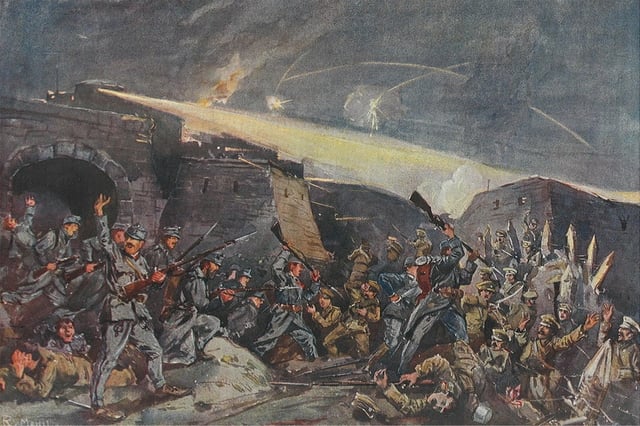
Siege of Przemyśl in 1915
On the Eastern front, the war started out equally poorly. The Austro-Hungarian Army was defeated at the Battle of Lemberg and the great fortress city of Przemyśl was besieged and fell in March 1915. The Gorlice–Tarnów Offensive started as a minor German offensive to relieve the pressure of the Russian numerical superiority on the Austro-Hungarians, but the cooperation of the Central Powers resulted in huge Russian losses and the total collapse of the Russian lines, and their 100 km (62 mi) long retreat into Russia. The Russian Third Army perished. In summer 1915, the Austro-Hungarian Army, under a unified command with the Germans, participated in the successful Gorlice–Tarnów Offensive. From June 1916, the Russians focused their attacks on the Austro-Hungarian army in the Brusilov Offensive, recognizing the numerical inferiority of the Austro-Hungarian army. By the end of September 1916, Austria-Hungary mobilized and concentrated new divisions, and the successful Russian advance was halted and slowly repelled; but the Austrian armies took heavy losses (about 1 million men) and never recovered. The Battle of Zborov (1917) was the first significant action of the Czechoslovak Legions, who fought for the independence of Czechoslovakia against the Austro-Hungarian army. However the huge losses in men and material inflicted on the Russians during the offensive contributed greatly to the revolutions of 1917, and it caused an economic crash in the Russian Empire.
Italian front 1915–1918
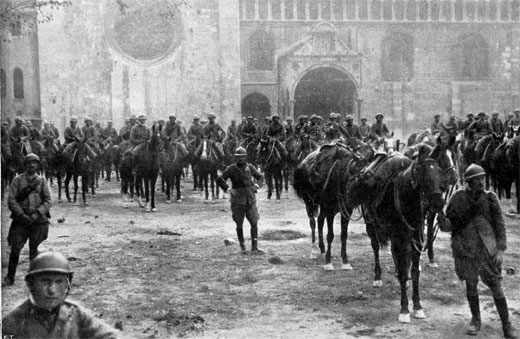
Italian troops in Trento on 3 November 1918, after the Battle of Vittorio Veneto. Italy's victory marked the end of the war on the Italian Front and secured the dissolution of Austria-Hungary.[188]
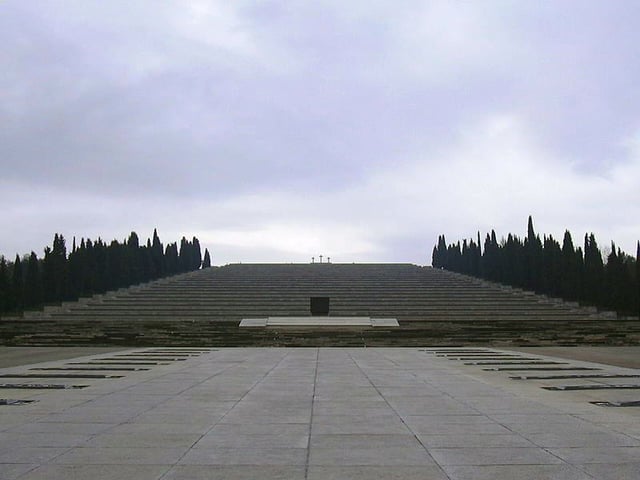
The Redipuglia War Memorial (Italy), the resting place of approximately 100,000 Italian soldiers dead in battles of the First World War
In May 1915, Italy attacked Austria-Hungary. Italy was the only military opponent of Austria-Hungary which had a similar degree of industrialization and economic level; moreover, her army was numerous (≈1,000,000 men were immediately fielded), but suffered from poor leadership, training and organization. Chief of Staff Luigi Cadorna marched his army towards the Isonzo river, hoping to seize Ljubljana, and to eventually threaten Vienna. However, the Royal Italian Army were halted on the river, where four battles took place over five months (23 June – 2 December 1915). The fight was extremely bloody and exhausting for both the contenders.[189]
On 15 May 1916, the Austrian Chief of Staff Conrad von Hötzendorf launched the Strafexpedition ("punitive expedition"): the Austrians broke through the opposing front and occupied the Asiago plateau. The Italians managed to resist and in a counteroffensive seized Gorizia on 9 August. Nonetheless, they had to stop on the Carso, a few kilometres away from the border. At this point, several months of indecisive trench warfare ensued (analogous to the Western front). As the Russian Empire collapsed as a result of the Bolshevik Revolution and Russians ended their involvement in the war, Germans and Austrians were able to move on the Western and Southern fronts much manpower from the erstwhile Eastern fighting.
On 24 October 1917, Austrians (now enjoying decisive German support) attacked at Caporetto using new infiltration tactics; although they advanced more than 100 km (62.14 mi) in the direction of Venice and gained considerable supplies, they were halted and could not cross the Piave river. Italy, although suffering massive casualties, recovered from the blow, and a coalition government under Vittorio Emanuele Orlando was formed. Italy also enjoyed support by the Entente powers: by 1918, large amounts of war materials and a few auxiliary American, British, and French divisions arrived in the Italian battle zone.[190] Cadorna was replaced by General Armando Diaz; under his command, the Italians retook the initiative and won the decisive Battle of the Piave river (15–23 June 1918), in which some 60,000 Austrian and 43,000 Italian soldiers were killed. The multiethnic Austro-Hungarian Empire started to disintegrate, leaving its army alone on the battlefields. The final battle was at Vittorio Veneto; after 4 days of stiff resistance, Italian troops crossed the Piave River, and after losing 90,000 men the defeated Austrian troops retreated in disarray pursued by the Italians. The Italians captured 448,000 Austrian-Hungarian soldiers about one-third of the imperial-royal army, 24 of whom were generals,[191] 5,600 cannons and mortars, and 4,000 machine guns.[192] The military breakdown also marked the start of the rebellion for the numerous ethnicities who made up the multiethnic Empire, as they refused to keep on fighting for a cause which now appeared senseless. These events marked the end of Austria-Hungary, which collapsed on 31 October 1918. The armistice was signed at Villa Giusti on 3 November.
Romanian front 1916–1917
On 27 August 1916, Romania declared war against Austria-Hungary. The Romanian Army crossed the borders of Eastern Hungary (Transylvania), and despite initial successes, by November 1916, the Central Powers formed by the Austro-Hungarian, German, Bulgarian, and Ottoman armies, had defeated the Romanian and Russian armies of the Entente Powers, and occupied the southern part of Romania (including Oltenia, Muntenia and Dobruja). On 6 December, the Central Powers captured Bucharest, the Romanian capital city, and part of the population moved to the unoccupied Romanian territory, in Moldavia, together with the Romanian government, royal court and public authorities, which relocated to Iași.[193]
In 1917, after several defensive victories (managing to stop the German-Austro-Hungarian advance), with Russia's withdrawal from the war following the October Revolution, Romania was forced to drop out of the war.[194]
Whereas the German army realized it needed close cooperation from the homefront, Habsburg officers saw themselves as entirely separate from the civilian world, and superior to it. When they occupied productive areas, such as southern Romania[195], they seized food stocks and other supplies for their own purposes, and blocked any shipments intended for civilians back in the Austro-Hungarian Empire. The result was that the officers lived well, as the civilians began to starve. Vienna even transferred training units to Serbia and Poland for the sole purpose of feeding them. In all, the Army obtained about 15 percent of its cereal needs from occupied territories.[196]
Role of Hungary
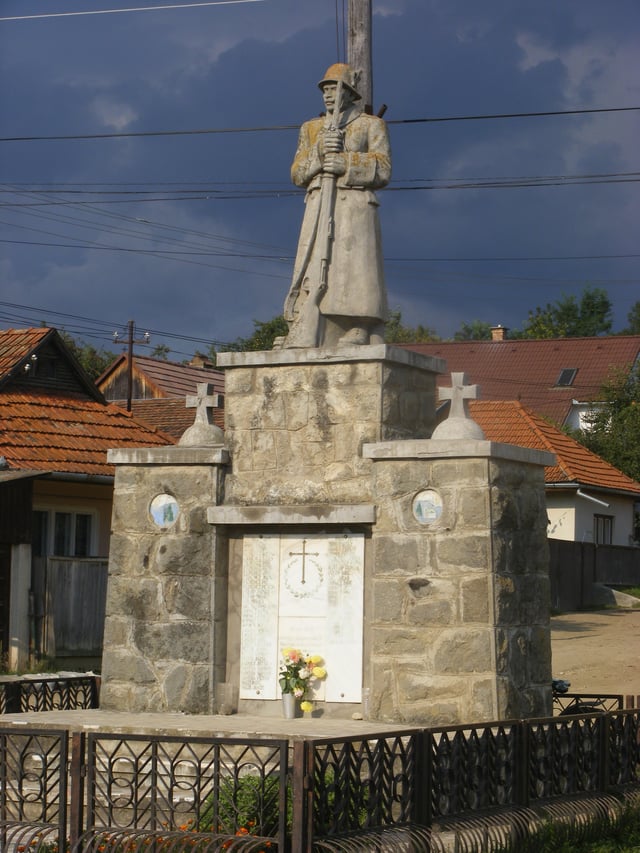
War memorial in Păuleni-Ciuc, Romania
Although the Kingdom of Hungary composed only 42% of the population of Austria-Hungary,[197] the thin majority – more than 3.8 million soldiers – of the Austro-Hungarian armed forces were conscripted from the Kingdom of Hungary during the First World War. Roughly 600,000 soldiers were killed in action, and 700,000 soldiers were wounded in the war.[198]
Austria-Hungary held on for years, as the Hungarian half provided sufficient supplies for the military to continue to wage war.[145] This was shown in a transition of power after which the Hungarian prime minister, Count István Tisza, and foreign minister, Count István Burián, had decisive influence over the internal and external affairs of the monarchy.[145] By late 1916, food supply from Hungary became intermittent and the government sought an armistice with the Entente powers. However, this failed as Britain and France no longer had any regard for the integrity of the monarchy because of Austro-Hungarian support for Germany.[145]
Analysis of defeat
The setbacks that the Austrian army suffered in 1914 and 1915 can be attributed to a large extent to Austria-Hungary becoming a military satellite of Imperial Germany from the first day of the war. They were made worse by the incompetence of the Austrian high command.[145] After attacking Serbia, its forces soon had to be withdrawn to protect its eastern frontier against Russia's invasion, while German units were engaged in fighting on the Western Front. This resulted in a greater than expected loss of men in the invasion of Serbia.[145] Furthermore, it became evident that the Austrian high command had had no plans for a possible continental war and that the army and navy were also ill-equipped to handle such a conflict.[145]
From 1916, the Austro-Hungarian war effort became more and more subordinated to the direction of German planners. The Austrians viewed the German army favorably, on the other hand by 1916 the general belief in Germany was that Germany, in its alliance with Austria-Hungary, was "shackled to a corpse". The operational capability of the Austro-Hungarian army was seriously affected by supply shortages, low morale and a high casualty rate, and by the army's composition of multiple ethnicities with different languages and customs.
The last two successes for the Austrians, the Romanian Offensive and the Caporetto Offensive, were German-assisted operations. As the Dual Monarchy became more politically unstable, it became more and more dependent on German assistance. The majority of its people, other than Hungarians and German Austrians, became increasingly restless.
In 1917, the Eastern front of the Entente Powers completely collapsed.
The Austro-Hungarian Empire then withdrew from all defeated countries. By 1918, the economic situation had deteriorated. Leftist and pacifist political movements organized strikes in factories, and uprisings in the army had become commonplace. During the Italian battles, the Czechoslovaks and Southern Slavs declared their independence. On 31 October Hungary ended the personal union with Austria, officially dissolving the Monarchy. At the last Italian offensive, the Austro-Hungarian Army took to the field without any food and munition supply, and fought without any political supports for a de facto non-existent empire. On the end of the decisive joint Italian, British and French offensive at Vittorio Veneto, the disintegrated Austria-Hungary signed the Armistice of Villa Giusti on 3 November 1918.
The government had failed badly on the homefront. Historian Alexander Watson reports:
across central Europe ... The majority lived in a state of advanced misery by the spring of 1918, and conditions later worsened, for the summer of 1918 saw both the drop in food supplied to the levels of the 'turnip winter', and the onset of the 1918 flu pandemic that killed at least 20 million worldwide. Society was relieved, exhausted and yearned for peace.[199]
Dissolution
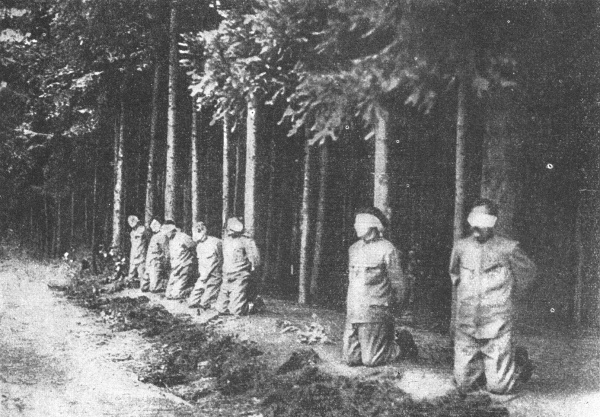
The revolt of ethnic Czech units in Austria in May 1918 was brutally suppressed. It was considered a mutiny by the code of military justice.
The Austro-Hungarian Monarchy collapsed with dramatic speed in the autumn of 1918. In the capital cities of Vienna and Budapest, the leftist and liberal movements and politicians (the opposition parties) strengthened and supported the separatism of ethnic minorities. These leftist or left-liberal pro-Entente maverick parties opposed the monarchy as a form of government and considered themselves internationalist rather than patriotic. Eventually, the German defeat and the minor revolutions in Vienna and Budapest gave political power to the left/liberal political parties. As it became apparent that the Allied powers would win World War I, nationalist movements, which had previously been calling for a greater degree of autonomy for various areas, started pressing for full independence. The Emperor had lost much of his power to rule, as his realm disintegrated.[200]
Alexander Watson argues that, "The Habsburg regime's doom was sealed when Wilson's response to the note, sent two and a half weeks earlier, arrived on 20 October." Wilson rejected the continuation of the dual monarchy as a negotiable possibility.[201] As one of his Fourteen Points, President Woodrow Wilson demanded that the nationalities of Austria-Hungary have the "freest opportunity to autonomous development". In response, Emperor Karl I agreed to reconvene the Imperial Parliament in 1917 and allow the creation of a confederation with each national group exercising self-governance. However, the leaders of these national groups rejected the idea; they deeply distrusted Vienna and were now determined to get independence.
On 14 October 1918, Foreign Minister Baron István Burián von Rajecz[202] asked for an armistice based on the Fourteen Points. In an apparent attempt to demonstrate good faith, Emperor Karl issued a proclamation ("Imperial Manifesto of 16 October 1918") two days later which would have significantly altered the structure of the Austrian half of the monarchy. The Polish majority regions of Galicia and Lodomeria were to be granted the option of seceding from the empire, and it was understood that they would join their ethnic brethren in Russia and Germany in resurrecting a Polish state. The rest of Cisleithania was transformed into a federal union composed of four parts—German, Czech, South Slav and Ukrainian. Each of these was to be governed by a national council that would negotiate the future of the empire with Vienna. Trieste was to receive a special status. No such proclamation could be issued in Hungary, where Hungarian aristocrats still believed they could subdue other nationalities and maintain the "Holy Kingdom of St. Stephen".
It was a dead letter. Four days later, on 18 October, United States Secretary of State Robert Lansing replied that the Allies were now committed to the causes of the Czechs, Slovaks and South Slavs. Therefore, Lansing said, autonomy for the nationalities – the tenth of the Fourteen Points – was no longer enough and Washington could not deal on the basis of the Fourteen Points anymore. In fact, a Czechoslovak provisional government had joined the Allies on 14 October. The South Slavs in both halves of the monarchy had already declared in favor of uniting with Serbia in a large South Slav state by way of the 1917 Corfu Declaration signed by members of the Yugoslav Committee. Indeed, the Croatians had begun disregarding orders from Budapest earlier in October.
The Lansing note was, in effect, the death certificate of Austria-Hungary. The national councils had already begun acting more or less as provisional governments of independent countries. With defeat in the war imminent after the Italian offensive in the Battle of Vittorio Veneto on 24 October, Czech politicians peacefully took over command in Prague on 28 October (later declared the birthday of Czechoslovakia) and followed up in other major cities in the next few days. On 30 October, the Slovaks followed in Martin. On 29 October, the Slavs in both portions of what remained of Austria-Hungary proclaimed the State of Slovenes, Croats and Serbs. They also declared that their ultimate intention was to unite with Serbia and Montenegro in a large South Slav state. On the same day, the Czechs and Slovaks formally proclaimed the establishment of Czechoslovakia as an independent state.
In Hungary, the most prominent opponent of continued union with Austria, Count Mihály Károlyi, seized power in the Aster Revolution on 31 October. Charles was all but forced to appoint Károlyi as his Hungarian prime minister. One of Károlyi's first acts was to cancel the compromise agreement, officially dissolving the Austro-Hungarian state.
By the end of October, there was nothing left of the Habsburg realm but its majority-German Danubian and Alpine provinces, and Karl's authority was being challenged even there by the German-Austrian state council.[203] Karl's last Austrian prime minister, Heinrich Lammasch, concluded that Karl was in an impossible situation, and persuaded Karl that the best course was to relinquish, at least temporarily, his right to exercise sovereign authority.
Consequences
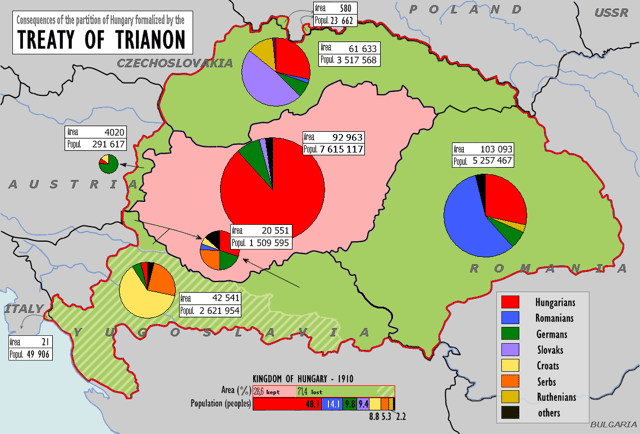
The Treaty of Trianon: Kingdom of Hungary lost 72% of its land and 3.3 million people of Hungarian ethnicity.
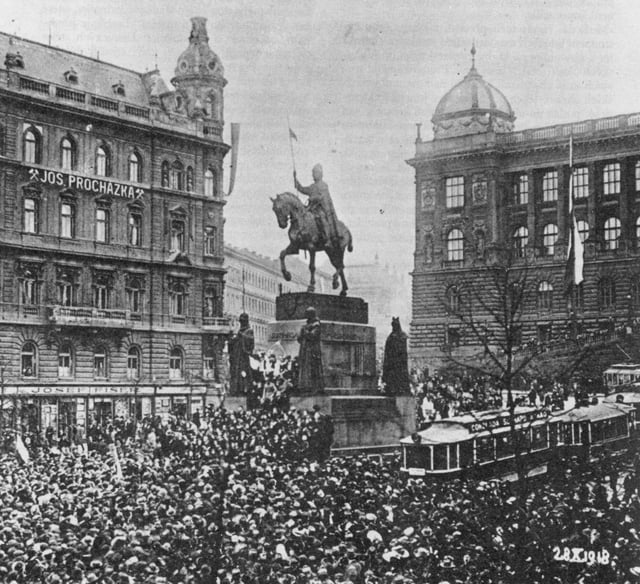
Czechoslovak declaration of independence rally in Prague on Wenceslas Square, 28 October 1918
On 11 November, Karl issued a carefully worded proclamation in which he recognized the Austrian people's right to determine the form of the state. He also renounced the right to participate in Austrian affairs of state. He also dismissed Lammasch and his government from office and released the officials in the Austrian half of the empire from their oath of loyalty to him. Two days later, he issued a similar proclamation for Hungary. However, he did not abdicate, remaining available in the event the people of either state should recall him. For all intents and purposes, this was the end of Habsburg rule.
Karl's refusal to abdicate was ultimately irrelevant. On the day after he announced his withdrawal from Austria's politics, the German-Austrian National Council proclaimed the Republic of German Austria. Károlyi followed suit on 16 November, proclaiming the Hungarian Democratic Republic.
The Treaty of Saint-Germain-en-Laye (between the victors of World War I and Austria) and the Treaty of Trianon (between the victors and Hungary) regulated the new borders of Austria and Hungary, leaving both as small landlocked states. The Allies assumed without question that the minority nationalities wanted to leave Austria and Hungary, and also allowed them to annex significant blocks of German- and Hungarian-speaking territory. As a result, the Republic of Austria lost roughly 60% of the old Austrian Empire's territory. It also had to drop its plans for union with Germany, as it was not allowed to unite with Germany without League approval. The restored Kingdom of Hungary, which had replaced the republican government in 1920, lost roughly 72% of the pre-war territory of the Kingdom of Hungary.
The decisions of the nations of the former Austria-Hungary and of the victors of the Great War, contained in the heavily one-sided treaties, had devastating political and economic effects. The previously rapid economic growth of the Dual Monarchy ground to a halt because the new borders became major economic barriers. All the formerly well-established industries, as well as the infrastructure supporting them, were designed to satisfy the needs of an extensive realm. As a result, the emerging countries were forced to make considerable sacrifices to transform their economies. The treaties created major political unease. As a result of these economic difficulties, extremist movements gained strength; and there was no regional superpower in central Europe.
The new Austrian state was, at least on paper, on shakier ground than Hungary. While what was left of Austria had been a single unit for over 700 years, it was united only by loyalty to the Habsburgs. With the loss of 60% of the Austrian Empire's prewar territory, Vienna was now an imperial capital without an empire to support it. By comparison, Hungary had been a nation and a state for over 900 years. However, after a brief period of upheaval and the Allies' foreclosure of union with Germany, Austria established itself as a federal republic. Despite the temporary Anschluss with Nazi Germany, it still survives today. Adolf Hitler cited that all "Germans" – such as him and the others from Austria, etc. – should be united with Germany.
Hungary, however, was severely disrupted by the loss of 72% of its territory, 64% of its population and most of its natural resources. The Hungarian Democratic Republic was short-lived and was temporarily replaced by the communist Hungarian Soviet Republic. Romanian troops ousted Béla Kun and his communist government during the Hungarian–Romanian War of 1919.
In the summer of 1919, a Habsburg, Archduke Joseph August, became regent, but was forced to stand down after only two weeks when it became apparent the Allies would not recognise him.[204] Finally, in March 1920, royal powers were entrusted to a regent, Miklós Horthy, who had been the last commanding admiral of the Austro-Hungarian Navy and had helped organize the counter-revolutionary forces. It was this government that signed the Treaty of Trianon under protest on 4 June 1920 at the Grand Trianon Palace in Versailles, France.[205][206]
In March and again in October 1921, ill-prepared attempts by Karl to regain the throne in Budapest collapsed. The initially wavering Horthy, after receiving threats of intervention from the Allied Powers and neighboring countries, refused his cooperation. Soon afterward, the Hungarian government nullified the Pragmatic Sanction, effectively dethroning the Habsburgs. Two years later, Austria had passed the "Habsburg Law," which not only dethroned the Habsburgs, but banned Karl from ever returning to Austria again.
Subsequently, the British took custody of Karl and removed him and his family to the Portuguese island of Madeira, where he died the following year.
Successor states
The following successor states were formed (entirely or in part) on the territory of the former Austria-Hungary:
German Austria and First Austrian Republic
Hungarian Democratic Republic, Hungarian Soviet Republic, and Kingdom of Hungary
Czecho-Slovakia ("Czechoslovakia" from 1920 to 1938)
State of Slovenes, Croats and Serbs (joined on 1 December 1918 with the Kingdom of Serbia to form the Kingdom of Serbs, Croats and Slovenes, later Kingdom of Yugoslavia)
Second Polish Republic
West Ukrainian People's Republic (united with the Ukrainian People's Republic through Act Zluky, while its territory was fully overran by the Second Polish Republic)
Duchy of Bukovina, Transylvania and two-thirds of the Banat were joined to the Kingdom of Romania
Austro-Hungarian lands were also ceded to the Kingdom of Romania and the Kingdom of Italy. The Principality of Liechtenstein, which had formerly looked to Vienna for protection, formed a customs and defense union with Switzerland, and adopted the Swiss currency instead of the Austrian. In April 1919, Vorarlberg – the westernmost province of Austria – voted by a large majority to join Switzerland; however, both the Swiss and the Allies disregarded this result.
 New borders of Austria-Hungary after the Treaty of Trianon and Saint Germain Border of Austria-Hungary in 1914 Borders in 1914 Borders in 1920 Empire of Austria in 1914 Kingdom of Hungary in 1914 Bosnia and Herzegovina in 1914 |
Territorial legacy
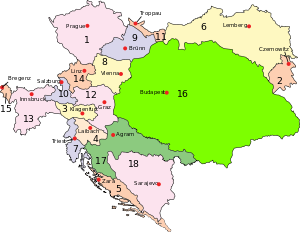 Kingdoms and countries of Austria-Hungary: Cisleithania (Empire of Austria[8]): 1. Bohemia, 2. Bukovina, 3. Carinthia, 4. Carniola, 5. Dalmatia, 6. Galicia, 7. Küstenland, 8. Lower Austria, 9. Moravia, 10. Salzburg, 11. Silesia, 12. Styria, 13. Tyrol, 14. Upper Austria, 15. Vorarlberg; Transleithania (Kingdom of Hungary[8]): 16. Hungary proper 17. Croatia-Slavonia; 18. Bosnia and Herzegovina (Austro-Hungarian condominium) |
The following present-day countries and parts of countries were within the boundaries of Austria-Hungary when the empire was dissolved:
Empire of Austria (Cisleithania):
Austria (except Burgenland)
Czech Republic (except the Hlučínsko area)
Slovenia (except Prekmurje)
Italy (Trentino, South Tyrol, parts of the province of Belluno and small portions of Friuli-Venezia Giulia)
Croatia (Dalmatia, Istria)
Poland (voivodeships of Lesser Poland, Subcarpathia, southernmost part of Silesia (Bielsko and Cieszyn))
Ukraine (oblasts of Lviv, Ivano-Frankivsk, Ternopil (except its northern corner) and most of the oblast of Chernivtsi)
Romania (county of Suceava)
Montenegro (bay of Boka Kotorska, the coast and the immediate hinterland around the cities of Budva, Petrovac and Sutomore)
Kingdom of Hungary (Transleithania):
Austria (Burgenland)
Slovenia (Prekmurje)
Croatia (Croatian Baranja and Međimurje county, while Slavonia and Central Croatia were not part of Hungary proper, as they were part of the sovereign Kingdom of Croatia-Slavonia)
Ukraine (oblast of Zakarpattia)
Romania (region of Transylvania, Partium and parts of Banat, Crișana, and Maramureș)
Serbia (autonomous province of Vojvodina and northern Belgrade region)
Poland (Polish parts of Orava and Spiš)
Austro-Hungarian Condominium
Bosnia and Herzegovina (the villages of Zavalje, Mali Skočaj and Veliki Skočaj including the immediate surrounding area west of the city of Bihać)
Montenegro (Sutorina – western part of the Municipality of Herceg Novi between present borders with Croatia (SW) and Bosnia and Herzegovina (NW), Adriatic coast (E) and the township of Igalo (NE))
Sandžak-Raška region, Austro-Hungarian occupied 1878 until withdrawal in 1908 whilst formally part of the Ottoman Empire
Possessions of the Austro-Hungarian Monarchy
The empire was unable to gain and maintain large colonies owing to its geographical position. Its only possession outside of Europe was its concession in Tianjin, China, which it was granted in return for supporting the Eight-Nation Alliance in suppressing the Boxer Rebellion. However although the city was only an Austro-Hungarian possession for 16 years, the Austro-Hungarians left their mark on that area of the city, in the form of architecture that still stands in the city.[207]
Other parts of Europe had been part of the Habsburg monarchy once but had left it before its dissolution in 1918. Prominent examples are the regions of Lombardy and Veneto in Italy, Silesia in Poland, most of Belgium and Serbia, and parts of northern Switzerland and southwestern Germany. They persuaded the government to search out foreign investment to build up infrastructure such as railroads. Despite these measures, Austria-Hungary remained resolutely monarchist and authoritarian.
Flags and heraldry
Flags
Austria-Hungary did not have a common flag (a "national flag" could not exist since the Dual Monarchy consisted of two sovereign states). However, the flag of the ruling Habsburg Dynasty was sometimes used as a de facto national flag and a common civil ensign was introduced in 1869 for civilian vessels. Until 1918, the k.u.k. War Fleet continued to carry the Austrian ensign it had used since 1786; and the regiments of the k.u.k. Army carried the double-eagle banners they had used before 1867, as they had a long history in many cases. New ensigns created in 1915 were not implemented due to the ongoing war. At state functions, the Austrian black-yellow and the Hungarian red-white-green tricolor were used.
Austria was represented by the black-yellow flag. The Hungarian half of the state, on the other hand, legally had no flag of its own.[209] According to the Croatian–Hungarian Settlement (art. 62 and 63), in all joint Croatian and Hungarian affairs symbols of both Croatia and Hungary respectively had to be used. For instance, whenever the joint Hungarian-Croatian Parliament held its session in Budapest, both the Croatian and Hungarian flags were hoisted on the parliament building in Budapest.[209][210][211] In Vienna, in front of Schönbrunn Palace, the black and yellow flag was flown for Cisleithania, while both Croatian and Hungarian flags were flown for Transleithania.[211] Hungary proper used a red-white-green tricolor defaced with the Hungarian coat of arms, sometimes used to represent the entirety of the Lands of the Hungarian Crown.
Coat of arms
The double-headed eagle of the House of Habsburg was used as the coat of arms of the common institutions of Austria-Hungary between 1867 and 1915. In 1915, a new one was introduced, which combined the coat of arms of the two halves of the Dual Monarchy and that of the dynasty.
Additionally, each of the two parts of Austria-Hungary had its own coat of arms.
See also
Aftermath of World War I
Austrian nobility
Corporative federalism, a form of administration adopted by the Austro-Hungarian Empire.
Diplomatic history of World War I
Czech lands: 1867–1918
Ethnic composition of Austria-Hungary
Former countries in Europe after 1815
Hungarian nobility
United States of Greater Austria












